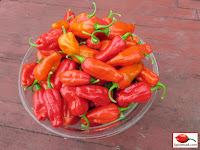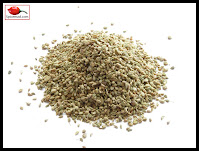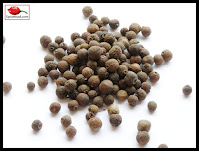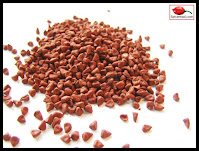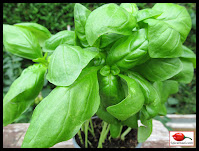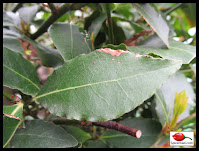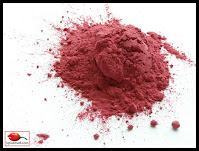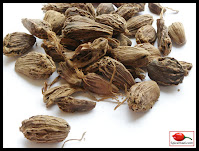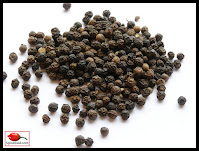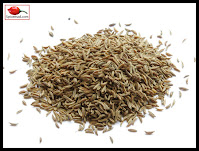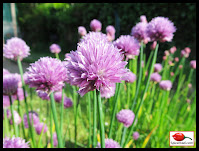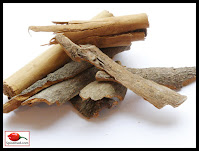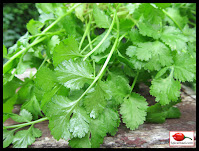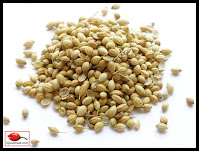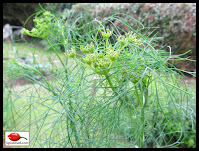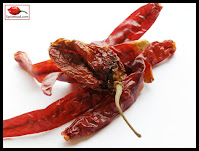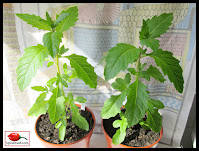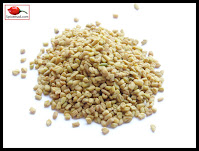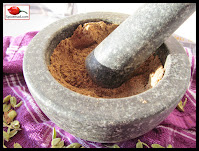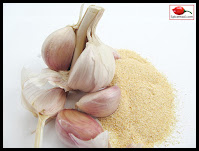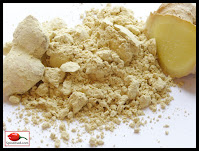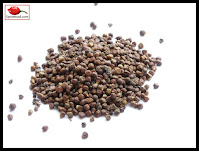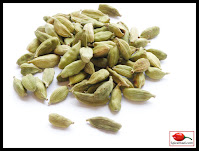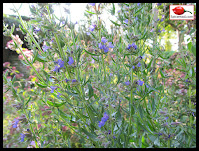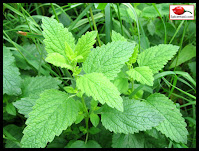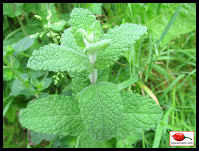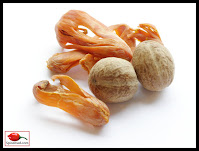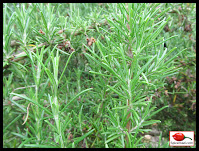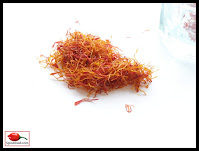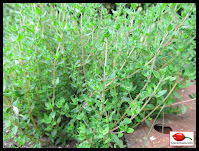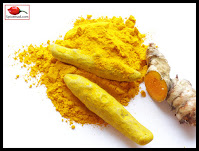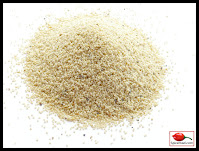Herbs and Spices
Hopefully this page will be of assistance to those of you who may be unfamiliar with any of the herbs and spices listed in some of the hot and spicy recipes on the blog. Spices should ideally be purchased in whole form and then ground fresh as and when they're needed using an electric coffee grinder or a pestle and mortar. When treated this way they'll always have a longer shelf life and a superior aroma and flavour.
However, there are some spices, such as turmeric, ginger, paprika and chilli powder, that you'll need to purchase in ground form because it's just not very practical to grind them yourself at home. Whole dried ginger and turmeric can be as hard as rock and when trying to grind them yourself using an electric coffee grinder you'll just damage the blades! Herbs and spices should always be stored in airtight jars and away from direct sunlight.
Ajwain seed (Trachyspermum ammi), also known as 'ajowan', 'carom seed' and 'bishop's weed', is the small oval-shaped, greyish-green coloured seed (fruit) of an annual plant native to Egypt and the Eastern Mediterranean. It has an aroma very similar to that of thyme, but much stronger, because just like thyme, it also contains thymol, which is the major component of thyme oil.
It is used sparingly to flavour certain vegetable dishes and lentil dishes and is often added to breads, pastries and deep fried foods, such as vegetable pakora and gathiya, the large crunchy stick pieces found in Bombay mix. Ajwain seed should not be confused with caraway seed (Carum carvi), which has very different qualities.
Allspice (Pimenta dioica), also known as 'pimienta', 'pimento', 'Jamaica pepper' and 'myrtle pepper', is the dried, brown coloured, unripe green berry (fruit) of a small to medium-sized tropical evergreen tree native to the West Indies and Southern Mexico. It was given the name 'allspice' because the aroma is said to resemble a combination of cinnamon, nutmeg and clove.
It is more commonly used in the preparation of certain spice blends, such as Jamaican jerk seasoning and Yucatecan recado colorado and recado bistec pastes. It is also one of the spices added to mixed peppercorns. Allspice doesn't retain its aroma for very long, so is best purchased in small amounts.
Amchoor powder (Mangifera indica), also known as 'amchur', 'aamchoor' and 'dried mango powder', is made from green unripe mangoes that have been peeled, sun-dried and then ground into a fine powder. It is beige in colour and is used as a souring agent in Indian cuisine, especially in Northern India and other regions where lemons and limes (nimbu) are hard to find.
It is mostly used in vegetable dishes and is normally added towards the end of the cooking process. Amchoor powder is a key ingredient in chaat masala, a tangy Indian spice mixture used for garnishing fruits, vegetables and salads.
Anardana seed (Punica granatum), also known as 'dried pomegranate seed', is the dried reddish-brown coloured seed (grain) of a wild variety of pomegranate native to the Himalayas, Afghanistan and Persia but now cultivated in Western and Central Asia, Northern India and Mediterranean countries. The small deciduous trees bear small fruits that rarely exceed 3cm in diameter, and their seeds are very acidic.
It is very astringent and used as a souring agent in some Indian dishes, much like tamarind and amchoor powder. Sometimes the seeds are used raw and other times they are lightly toasted in a dry skillet or frying pan beforehand. Anardana can be purchased in either whole or ground form and is often an ingredient added to chana masala, a North Indian chickpea curry.
Annatto seed (Bixa orellana), also known as 'achiote seed', is the cone-shaped, orange-red coloured seed of a small evergreen tree native to the tropical regions of the Americas but now widely grown in tropical regions all over the world. It has a delicate floral, peppery aroma with faint minty undertones and is used as a natural yellow-orange colouring agent (E160b) in many processes foods, such as cheese and custard.
Annatto is mostly used in ground form as an ingredient in spice blends, such as the Yucatecan recado colorado paste, also known as recado rojo, but sometimes whole seeds are fried in hot fat for colour extraction. The resulting fat is then used for cooking certain dishes, such as rice dishes, whereby it gives the food a vibrant yellow-orange colour.
Basils (Ocimum basilicum), are aromatic annual, or sometimes perennial, plants belonging to the Lamiaceae family, which is known for its aromatic members, such as rosemary, sage, oregano, marjoram, hyssop, lemon balm and mint. They are native to tropical regions stretching from Africa to Southeast Asia but are now widely grown in many parts of the world.
There are many cultivars of basil, such as Thai basil (Ocimum basilicum thyrsifolium), which is native to Southeast Asia and has a slightly spicy anise-liquorice-like aroma and flavour; and purple basil (Ocimum basilicum var. Purpurescens), which is a purple-leaved variety that has an intense aroma and flavour. There are also several hybrids, such as African blue basil (Ocimum kilimandscharicum × basilicum var. Dark Opal), which is a cross between camphor basil (Ocimum kilimandscharicum) and dark opal basil (Ocimum basilicum var. Dark Opal), and is one of only a few types of basil that are perennial. There are also several species, such as holy basil (Ocimum tenuiflorum), also known as 'tulsi', which is a perennial plant native to the Indian subcontinent but now widespread throughout the Southeast Asian tropics; and camphor basil (Ocimum kilimandscharicum), which is a perennial plant native to Kenya, Tanzania, Uganda, Sudan and Ethiopia.
It can be used in either fresh or dried form, although fresh is by far superior, and is a popular herb in Asian, Middle Eastern and Mediterranean cuisines, where it is used for flavouring sauces, salads, egg dishes, tomato dishes, curries and meats. The type of basil most commonly used is called sweet basil, also known as 'Genovese basil', which is a cultivar of Ocimum basilicum. This type of basil is probably best known for its use in pesto, an Italian sauce consisting of olive oil, basil leaves, pine nuts, salt, garlic and hard cheese. The type of basil shown here in the photo is sweet basil.
The name 'bay leaf' could refer to the leaves of several different plants, but the usage typically remains the same. They are normally added whole to sauces, soups and stews and then removed and discarded at the end of the cooking process. They can be used in either fresh or dried form, although dried is more common, and are popular in many cuisines around the world.
The bay leaves shown in the photo here are of the European species, bay laurel (Laurus nobilis), also known as 'sweet bay', 'royal bay' and 'true laurel', which is an evergreen tree native to the Mediterranean but now widely grown in many parts of the world. They should be used quite sparingly because too many can impart a distinct bitter flavour.
Indian bay leaves (Cinnamomum tamala), also known as 'tej patta', belong to the same plant family as their European counterpart but come from an evergreen tree that is closely related to cinnamon and is native to the Southern Himalayas and mountains of Northeast India. They have a delicate cinnamon aroma with faint peppery undertones and are sometimes one of the ingredients used to make garam masala.
Beetroot powder (Beta vulgaris) is made from sliced dried beetroot that has been ground into a fine powder. It is a natural alternative to artificial food colouring and is sometimes used as a pink-red colouring agent in certain foods, such as salsas, sauces and raitas. It should be used very sparingly as food colouring because a little goes a very long way, and adding too much will impart a distinct earthy flavour.
Nowadays, beetroot powder is relatively cheap to buy and is sold as a nutrient rich super food. Often times it is added to vegetable juices, fruit juices, smoothies and soups for a nutritional boost.
Black cardamom (Amomum subulatum), also known as 'badi illaichi', 'kali illaichi', 'brown cardamom', 'greater cardamom', 'Nepal cardamom' and 'Bengal cardamom', is the highly aromatic, pungent deep brown coloured pod (fruit) of an herbaceous perennial plant native to the Eastern Himalayas. It is much larger than its green counterpart and has a strong camphor-like aroma with smoky and minty undertones.
It is mostly used in North Indian cuisine to flavour curries, rice dishes, dals, soups and stews. When used whole it is typically added into hot oil at the start of the curry cooking process. Black cardamom is also one of the ingredients used to make garam masala.
There are two types of black cardamom sold. One is the Indian variety, shown here in the photo, and the other is known as Chinese cardamom (Lanxangia tsaoko syn. Amomum tsao-ko), which is larger and has a softer casing.
Black cumin seed (Elwendia persica syn. Bunium persicum), also known as 'shahi jeera', 'kala jeera', 'Kashmiri jeera', 'Kashmiri cumin' and 'imperial cumin', is the elongated, crescent-shaped, dark brown-black coloured seed (fruit) of a perennial plant native to Central Asia through to Northern India. It can be described as having a medicinal-like aroma with smoky and earthy undertones.
It is not used very often and is little known outside of Afghanistan, Pakistan, Iran and Northern India. However, it can add a great effect to some North Indian dishes, such as kormas, biryanis and pilafs. Black cumin seed is sometimes one of the ingredients used to make Kashmiri garam masala, and in the same part of the world the root of the plant is also eaten as a vegetable.
Many people confuse this spice with caraway seed (Carum carvi), which has a very different aroma and is in no way interchangeable. Another spice wrongly labelled as 'black cumin seed' is kalonji seed (Nigella sativa), which again has very different qualities.
Black mustard seed (Brassica nigra), also known as 'rai' and 'sarson', is the small round, dark purple-black coloured seed of an annual plant native to tropical regions of North Africa, temperate regions of Europe and parts of Asia. It is considered to be the hottest and most pungent of all the mustard varieties, but once fried it becomes milder and takes on a nutty flavour.
It is a commonly used spice in South Indian cuisine and is typically fried in hot oil or ghee until the seeds splutter. This can either be at the start of the cooking process before adding onions or it can be used to temper hot oil, which is then poured over curries and dals at the end of the cooking process to add extra flavour. The seeds should be allowed to splutter in order for the flavour to be released.
Black pepper (Piper nigrum), also known as 'kali mirch', is native to Kerala in Southwest India and is sometimes referred to as 'king of spices' and 'black gold'. It is the world's most traded spice and archaeological evidence suggests it has been used in Indian cuisine since 2000 BC. The plant is a perennial woody vine that grows on trees, poles or trellises and can reach up to 13-feet in height.
Peppercorns (fruit) develop on flower spikes, which are picked at different stages of maturity to produce green, black, red and white peppercorns. Black pepper is one of the key ingredients used to make garam masala and was the main heat-giving agent in Indian cuisine before chilli peppers were introduced by the Portuguese towards the end of the fifteenth century.
Green pepper is the unripe fruit that has either been freeze-dried or preserved in brine or vinegar. It has a fresh and spicy, aromatic herbal aroma and is a popular ingredient in Thai cuisine.
Black pepper is the unripe fruit that has been harvested just before ripening. It is dipped in hot water to disinfect the surface and then machine-dried or sun-dried, during which time the skin around the seed begins to shrink and darken before eventually turning black. Sometimes the fruit is separated from the stem by hand and then sun-dried without the hot water treatment. It has a sharp pungent aroma, but less so than white pepper.
Red pepper is the ripe fruit that has either been freeze-dried or preserved in brine or vinegar. The fruit has to be harvested at the correct time, and if drying, the process has to be fast in order to preserve the colour. It has a fresh and spicy, aromatic aroma and is more pungent than black pepper. Red peppercorns should not be confused with pink pepper, which is the fruit of the Peruvian pepper tree (Schinus molle), or its relative, the Brazilian pepper tree (Schinus terebinthifolia), both of which are from a different plant family.
White pepper is the seed of the ripe fruit with the skin removed. This process is achieved by soaking the fruit in water for about one week, after which time the skin disintegrates and can be easily removed. The remaining seed is then dried. It has an herbaceous, medicinal-like aroma and is much sharper than black pepper. It is a popular table condiment and whole berries are added to mixed peppercorns.
Caraway seed (Carum carvi), also known as 'Persian cumin' and 'meridian fennel', is the elongated, brown coloured seed (fruit) of a biennial plant native to Western Asia, Europe and North Africa. It can be described as having an aniseed-liquorice-like aroma with undertones of peppermint, and is an ancient spice that was used by the Romans for culinary and medicinal purposes.
It is typically used in whole form to flavour breads, cakes, desserts, liquors, stews and casseroles. Although it has a similar appearance to white cumin (Cuminum cyminum), and is often confused with black cumin (Elwendia persica), all three are very different spices and are in no way interchangeable.
Chilli flakes are a condiment or spice made from dried red chilli peppers that have been crushed or coarsely ground. They are not an essential ingredient in the preparation of curries and other such dishes, but they do provide a nice depth of flavour. The typical bog-standard chilli flakes sold at supermarkets are made from chillies belonging to either the Capsicum annuum or Capsicum frutescens species.
They are used as a table condiment in some parts of the world and are a quick and convenient way to spice up individual portions of food. They are great sprinkled over potato dishes, roasted vegetables and pizzas. They are also sometimes used to temper hot oil or ghee, which is then poured over curries and dals at the end of the cooking process to add extra heat and flavour.
Unless otherwise stated, when any of the recipes on this blog call for chilli flakes to be added, I'm referring to the bog-standard type sold at your local supermarket or Indian grocery store.
Chilli powder is made from dried red chilli peppers that have been ground into a fine powder. It is available in several heat grades, from mild to extra hot, and the colour can range from orange to dark red, depending on the type of chillies used. The typical bog-standard chilli powder sold at Indian grocery stores is made from chillies belonging to either the Capsicum annuum or Capsicum frutescens species.
Supermarkets sell a spice called 'Cayenne pepper', which traditionally is a type of chilli powder made from dried and ground Cayenne peppers, a group of moderately hot, tapering, 10–25cm long, generally skinny and mostly red coloured chilli peppers belonging to the Capsicum annuum species. However, nowadays the Cayenne pepper sold in supermarkets could be a blend of different chilli powders and may not even contain Cayenne peppers. Whatever the case may be, Cayenne pepper is the supermarket equivalent of the chilli powder I'm referring to in the recipes on this blog, and it is indistinguishable from the bog-standard type sold at Indian grocery stores.
To make things even more confusing, many supermarkets also sell a spice called 'chilli powder', which is normally a seasoning mix used for flavouring chili con carne and typically consists of ground cumin, salt, Cayenne pepper, garlic powder, dried oregano and anti-caking agent. This is not the type of chilli powder to use in the recipes on this blog!
Unless otherwise stated, when any of the recipes on this blog call for chilli powder to be added, I'm referring to the bog-standard type sold at Indian grocery stores. The supermarket equivalent of this is called Cayenne pepper.
Chive (Allium schoenoprasum), is an herbaceous perennial plant that likely originated in Central Asia but is now widespread across Europe, Asia and North America. Just like its close relatives, onion, garlic, leek and shallot, chive has a mild onion aroma and flavour with subtle undertones of garlic. It is the only species of Allium native to both the New and the Old worlds.
It is typically used fresh and is a popular herb in European, Asian and North American cuisines, where it is used for adding a delicate onion flavour to sauces, soups, stews, salads, mild cheeses, potato dishes, egg dishes and fish. Chive has a more delicate flavour than its native Himalayan counterpart, garlic chive (Allium tuberosum), but the usage is the same and both can be used interchangeably. The green stalks (scapes) are the part of the plant most commonly used, but the purple-pink flowers of chive and the white flowers of garlic chive are also edible and are sometimes added to salads.
There are two types of cinnamon commonly used in cooking. One is called Ceylon cinnamon (Cinnamomum verum syn. Cinnamomum zeylanicum), also known as 'true cinnamon', 'Sri Lankan cinnamon' and 'dalchini', and the other is called cassia cinnamon (Cinnamomum cassia syn. Cinnamomum aromaticum), also known as 'Chinese cinnamon' and 'Chinese cassia'.
Ceylon cinnamon is more expensive than cassia cinnamon and comes from a small evergreen tree native to Sri Lanka but now also grown in the Seychelles, Madagascar, South America and the West Indies. It is sold as tightly packed quills of thin bark, shown here in the upper left of the photo, and is lighter in colour and more fragile than cassia cinnamon. This type of cinnamon is considered to be superior by many people, and because of its sweeter, more delicate aroma is the one that works best in desserts.
Cassia cinnamon comes from an evergreen tree native to Southern China, Burma, Laos and Vietnam but is now widely grown throughout Southern and Eastern Asia. It is sold as thick, dark brown-reddish pieces of bark, shown here in the lower part of the photo, and is more robust and harder to grind than its Sri Lankan counterpart. Cassia cinnamon has a stronger aroma and flavour than Ceylon cinnamon and is the type you're most likely to find at the Indian grocery store.
Cinnamon, be it Ceylon cinnamon or cassia cinnamon, is used in both whole and ground form in many cuisines around the world. Sometimes whole cinnamon quills or pieces of cassia bark are added into hot oil at the start of the curry cooking process. It is also one of the ingredients used to make garam masala, a highly aromatic traditional Indian spice mixture.
Aside from Chinese cassia (Cinnamomum cassia syn. Cinnamomum aromaticum), which is the one most commonly sold in the United Kingdom, United States and India, another two species of cassia cinnamon are also sold commercially, but in much smaller amounts. One is called Vietnamese cassia (Cinnamomum loureiroi), also known as 'Vietnamese cinnamon' and 'Saigon cinnamon', and the other is called Padang cassia (Cinnamomum burmannii), also known as 'korintje', 'Batavia cassia' and 'Indonesian cinnamon'. All three are very similar to each other with only slight variations in shape, colour, aroma and Coumarin content, an anticoagulant found at much higher levels in cassia cinnamon than in Ceylon cinnamon, with Vietnamese cassia containing the highest amount.
Cloves (Syzygium aromaticum), also known as 'laung', are the dried unopened flower buds of a tropical evergreen tree native to the Northern part of the Maluku Islands (or the Moluccas) in Indonesia, once known as the Spice Islands because of the nutmeg, mace and cloves that were exclusively found there. The flower buds are picked and dried just as they turn bright red.
They have a highly aromatic, fragrant aroma and are used in many cuisines around the world to flavour meats, curries, fruits and marinades. Most of the fragrance resides in the bud, so try to avoid using headless specimens. Whole cloves are sometimes added into hot oil at the start of the curry cooking process and are a common ingredient in many spice mixtures, such as pumpkin pie spice, mixed spice, Chinese five spice powder and garam masala.
Coriander leaf (Coriandrum sativum), also known as 'cilantro' and 'Chinese parsley', is the leaf of the coriander plant, which is an annual plant native to the Eastern Mediterranean and Asia Minor but now widely grown in many parts of the world. The aroma can be described as refreshingly herbal with subtle earthy undertones, and very different from the citrus-like aroma of freshly ground coriander seed.
It is typically used fresh and is a very popular herb in South American, Central American, Middle Eastern and Asian cuisines, where it is used for garnishing foods such as dals, meat dishes, fish dishes, rice dishes, salads and curries, and for flavouring sauces, salsas, soups, stews and chutneys.
Coriander seed (Coriandrum sativum), also known as 'dhania', is the oval-shaped, yellow-beige-brown coloured seed (fruit) of an annual plant native to the Eastern Mediterranean and Asia Minor but now widely grown in many parts of the world. When freshly ground the aroma can be described as very citrus-like with undertones of orange, lemon or lime.
It is mostly used in ground form, whereby whole seeds are either ground raw or lightly toasted in a dry skillet or frying pan beforehand to help lift the aroma. Sometimes whole seeds are lightly fried in oil or ghee and then used as garnish for meats and vegetables. Coriander seed is widely used in many countries around the world to flavour foods such as curries, breads, sausages and pickles.
Curry leaf (Murraya koenigii), also known as 'kari patta', is the aromatic leaf of a small tropical to sub-tropical evergreen tree native to India. Curry trees can be found growing all over the Indian subcontinent but the leaves play a more important role in South Indian and Sri Lankan cuisines, where they are used extensively to flavour curries, rice dishes, soups and stews.
Curry leaves are typically used fresh and are added into hot oil at the start of the curry cooking process. They are also sometimes used to temper hot or ghee, which is then poured over curries, dals and other such dishes at the end of the cooking process to add extra flavour. They are also used by Ayurvedic practitioners and are believed to contain anti-microbial, anti-diabetic and anti-inflammatory properties. Dried curry leaves should be avoided because they have an inferior aroma and flavour.
Dill (Anethum graveolens), also known as 'dill weed', is an aromatic annual plant native to Central Asia but now widely grown in many parts of the world. It has a distinctly fresh aniseed-liquorice-like aroma with subtle undertones of celery, and has been used since ancient times for culinary, medicinal and spiritual purposes. Dill has been found in the tomb of Egyptian Pharoah Amenhotep II, dating to around 1400 BC.
The fern-like leaves can be used in either fresh or dried form, although fresh is by far superior, and it is a popular herb in European, Asian and Middle Eastern cuisines, where it is used for flavouring soups, sauces, salads, pickles, salad dressings, fish dishes, potato dishes, chicken dishes, egg dishes and rice dishes. Dill seed (fruit) is also used as a spice in some Middle Eastern and Asian dishes for flavouring foods such as pickles, curries and dals. There are two closely related cultivated species of dill, one is European dill (Anethum graveolens), shown here in the photo, and the other is Indian dill (Anethum sowa), which is native to Northern India and produces larger but less fragrant seed (fruit) than that of its European counterpart.
Dried chillies come in many different shapes, colours and sizes and the types used will depend greatly on the country, region and food being cooked. India is the world's largest producer of dried chillies, and produces some 1.6 million tonnes each year, meeting nearly half of the world's consumption demand. Other important producers are China, Thailand, Mexico, Peru, Ethiopia and Pakistan.
The types or varieties used will belong to one of the five domesticated Capsicum species — C. annuum, C. baccatum, C. chinense, C. frutescens and C. pubescens — although C. baccatum, C. chinense and C. pubescens varieties are more synonymous with Central American and South American cuisines and are not traditionally used in Asian cuisines. The types or varieties traditionally used in Asian cuisines belong to either the C. annuum or C. frutescens species. Most of the dried chillies sold at Indian grocery stores belong to either of these two species, although it may be possible to occasionally source dried Naga Morich or Bhut Jolokia chillies, both of which are Indian varieties and belong to the C. chinense species. You're more likely to find dried chillies belonging to the C. baccatum, C. chinense and C. pubescens species at Hispanic food stores, although it is very rare to find dried C. pubescens chillies anywhere. Perhaps this has to do with the peppers being thick-walled, which makes drying them a long and time consuming process.
Dried chillies can be added whole to sauces, soups, stews, curries and dals for a nice depth of flavour. When added to a dish in whole form, as opposed to ground form (chilli powder), they don't impart as much heat, so it's more about adding flavour than adding heat. Sometimes they are rehydrated in hot water or vinegar and then ground into a smooth paste, as is often the case when making vindaloo curry. Dried chillies are a common ingredient used in the preparation of certain spice blends, such as the South Indian gunpowder spice mix.
The well known dried Indian chillies are: single reshampatti, double reshampatti, Kashmiri, Byadgi, Goan, Tinnevelly, Guntur red, Nellore and yellow. In recent years there has been an increased fascination with the Kashmiri chilli, which is favoured for its mild heat and bright red colour that it gives to sauces. However, the ones being sold in the West (and even to some extent in India) are typically not the true Kashmiri type, but mild cash crop varieties instead, with Byadgi being the most common one.
The well known dried Mexican chillies are: Costeno Amarillo, Chile de Arbol, Ancho (known as Poblano when fresh), Chipotle (smoke-dried Jalapeño), Pasilla (known as Chilaca when fresh), Cascabel and Guajillo (known as Mirasol when fresh).
WARNING: always inspect dried chillies carefully before use, both inside and out, and look for any signs of mould. Dried chillies are one of the products that can be a source of exposure to aflatoxins, a hepatotoxic carcinogen produced by fungi, Aspergillus flavus and Aspergillus parasiticus being the two main culprits, both of which are abundant in warm and humid regions of the world. If you detect mould on one or more dried chillies then assume the rest of the bag could be contaminated with a potentially life threatening toxin and avoid using them!
Epazote (Dysphania ambrosioides syn. Chenopodium ambrosioides), also known as 'Mexican tea', 'Jesuit tea', 'skunkweed' and 'wormseed', is a short-lived perennial plant native to Central America, South America and Southern Mexico. It has an unusual pungent aroma that can be described as medicinal-like with undertones of turpentine, menthol and sometimes citrus.
It can be used in either fresh or dried form, although fresh has a superior aroma and is more common, and it is a popular herb in Mexican cuisine, especially Yucatecan cuisine, where it is used as a seasoning in black bean dishes and sometimes potato dishes, egg dishes, soups, quesadillas and enchiladas. It also has carminative properties and aids with the digestion process.
Epazote is fine when used as a seasoning, but can be very toxic when eaten in large amounts. It is one of the anthelmintic plants used by the medicine people of Central America to expel intestinal parasites, thus the name — 'wormseed'.
Fennel seed (Foeniculum vulgare), also known as 'saunf' and 'sweet cumin', is the elongated, light green coloured seed (fruit) of a hardy perennial plant native to the shores of the Mediterranean but now widely grown in many parts of the world. It is highly aromatic and can be described as warm, sweet and aniseed-like with subtle undertones of liquorice.
It is used in both whole and ground form in many cuisines around the world, particularly Middle Eastern and Asian cuisines. Fennel seed is used to make Chinese five spice powder, an aromatic spice blend consisting of cinnamon, clove, star anise, fennel and Sichuan pepper. It is also an important spice in Kashmiri cuisine, and is also used to make Bengali panch phoran, a mixture of five whole spices, consisting of cumin seed, fenugreek seed, kalonji seed, fennel seed and radhuni seed (Trachyspermum roxburghianum syn. Carum roxburghianum), although in the West black mustard seed is typically used as a substitute for radhuni seed.
Fenugreek seed (Trigonella foenum-graecum), also known as 'methi', is the cuboid-shaped, yellow-beige-amber coloured seed of an annual plant native to the Eastern Mediterranean but now widely grown all over Asia. It is an ancient spice and archaeological evidence of it has been found in the tomb of Tutankhamen, and at Tell Halal in Iraq, carbon dated to 4000 BC.
It is used in both whole and ground form and can be described as having a distinct curry-like or maple syrup-like aroma. Sometimes whole seeds are lightly toasted in a dry skillet or frying pan to help lift the aroma and reduce the strong bitterness. Fenugreek seed is a very popular spice in Middle Eastern, African and South Indian cuisines, where it is used to flavour breads, sauces, curries, pickles and beverages. It is also a common ingredient in many spice mixtures, such as curry powder, sambar powder and Bengali panch phoran.
Garam masala is a traditional Indian spice mixture consisting of aromatic spices and can be used in both whole and ground form. When used whole the spices are typically added into hot oil or ghee at the start of the curry cooking process for tempering. When used in ground form it is traditionally added at or towards the end of the cooking process. The word 'Garam' means hot and 'Masala' means spice mixture.
The main spices used to make traditional garam masala are black peppercorns, cloves, cinnamon, black cardamom and Indian bay leaf (tej patta). However, additional spices are often added, which may include coriander seed, white cumin seed, black cumin seed, fennel seed, star anise, nutmeg, mace, green cardamom, ground ginger and European bay leaf (Laurus nobilis).
Nowadays, there are almost as many recipes for garam masala as there are people who make it, and the spices used, and ratios of each, can depend largely on regional differences, personal or family preference and whims of the cook. Whole spices used to make garam masala are typically toasted in a dry skillet or frying pan before being ground to help lift the aroma. However, there are some people, myself included, who prefer not to toast the spices because all it does is burn off the essential oils and weaken the blend. I've found the best way to store garam masala power is in an airtight container in the freezer, where it retains its lovely aroma for many months.
Garlic (Allium sativum) is the bulb of a perennial flowering plant native to Central Asia and Northeastern Iran but now widely grown in many parts of the world. It is one of the most important and valued spices in the world and has long been used for both culinary and medicinal purposes. It was known to the ancient Egyptians and has been a common spice in Europe since the time of the Roman Empire.
Garlic is available in fresh, dried, granulated and ground form, although fresh is the form most commonly used. Fresh garlic bulbs, also known as 'garlic heads', should always be unblemished, firm to the touch and have dry skins. Avoid using specimens that are soft or have green sprouts growing from one or more of the cloves because this indicates they are old. Garlic is a popular spice in many cuisines around the world, particularly in Mediterranean and Asian cuisines, where it is used in many sauces, soups, stews, casseroles, salads, salad dressings and pickles.
Ground garlic, also known as 'powdered garlic' and 'garlic powder', is a spice made from sliced dried garlic cloves that have been ground into a fine powder. It is commonly used as a flavour enhancer in many spice mixtures, such as curry powder, Cajun seasoning and chili con carne seasoning mix. Nowadays, it is used less frequently in cooking due to fresh garlic being so readily available in shops and supermarkets. Granulated garlic is made and used in the same way as powdered garlic, except it is ground to a coarse texture. Both powdered garlic and granulated garlic should not be confused with garlic salt, which is a product made from powdered garlic and salt.
Ginger (Zingiber officinale), also known as 'adrak', is the large, fleshy rhizome of an herbaceous perennial plant native to Southeast Asia but now widely grown in tropical regions all over the world. It is one of the most important and valued spices in the world and belongs to the same plant family as turmeric, green cardamom, grains of paradise and galangal.
Ginger is available in fresh, dried and ground form, although fresh is the form most commonly used. Fresh ginger, also known as 'green ginger', should always be firm to the touch and have a vibrant beige coloured skin. Avoid using specimens that are soft because they will be very fibrous and dry. It is a popular spice in many cuisines around the world, particularly in Asian cuisine, where it is used in many curries, dals, soups, stews, salads, pickles and beverages.
Dried or ground ginger is more spicy than fresh and can be described as having a strong citrus-like aroma with peppery undertones. It is mostly used as an ingredient in baked goods and spice mixtures, such as mixed spice, a British spice blend that has been used for several centuries.
Grains of paradise (Aframomum melegueta), also known as 'Guinea pepper', 'melegueta pepper', 'alligator pepper', 'ossame' and 'fom wisa', is the reddish-brown coloured seed of an herbaceous perennial plant native to West Africa, namely Liberia, Ivory Coast, Ghana, Togo and Nigeria, although most imports come from Ghana. It can be described as having a fruity, peppery aroma with floral and earthy undertones.
It belongs to the same plant family as turmeric, ginger, galangal and green cardamom and is commonly used as a seasoning in North and West African cuisines, but rarely so elsewhere. Grains of paradise were once a very important spice in 15th century Europe and were used as a substitute for black pepper before the sea route to India had been discovered. The West African coast was given its name 'Pepper Coast', also known as 'Grain Coast', by the Portuguese because of the availability of this spice in the region.
Grains of paradise were once used as an ingredient in Great Britain to flavour beer, wine and other alcoholic beverages, but in the 18th century its importation collapsed after a parliamentary act was passed that forbade its use in alcoholic beverages.
Green cardamom (Elettaria cardamomum), also known as 'choti illaichi', 'hari illaichi' and 'true cardamom', is the highly aromatic, pungent green coloured pod (fruit) of an herbaceous perennial plant native to Southern India but now widely grown in tropical regions all over the world. It is sometimes referred to as 'queen of spices' and belongs to the same plant family as turmeric, ginger and black cardamom.
It is mostly used in South Indian and Sri Lankan cuisines to flavour curries, rice dishes, soups, stews, pickles, beverages, yoghurt and desserts. When used whole it is typically added into hot oil at the start of the curry cooking process. However, sometimes it may be added later on if a top note is required in the dish. The seeds contained within the pod are the most aromatic part, and occasionally they are ground and used as a finishing spice on meats and desserts.
Black cardamom and green cardamom are the two types most commonly used, but there also exists a white cardamom. Two types of white cardamom are sold. Green cardamom pods are sometimes bleached with sulphur dioxide and sold as white cardamom. This is done for aesthetic purposes and to give them a sweeter, more delicate aroma. The usage is typically confined to baking, and in most cases the unbleached version is preferred. However, the true white cardamom is the lesser known Siam cardamom (Amomum krervanh), which is approximately 1.5cm in diameter, beige in colour, chickpea-shaped and slightly ribbed. It is used mostly in Thai, Chinese, Cambodian and Vietnamese cuisines.
Hyssop (Hyssopus officinalis) is a bushy semi-evergreen shrub native to the Mediterranean and the Middle East but now widely grown in many parts of the world. It has a somewhat medicinal, aromatic, skunky mint-like aroma and was a popular herb during the Middle Ages for flavouring soups, stews and stuffings. However, today its usage as a culinary herb is much less common.
The leaves and flowers are typically used together in either fresh or dried form, although fresh is by far superior, to flavour potato dishes, bean dishes, soups, stews, salads, vegetables, fish, meats and spirits and liqueurs, such as Absinthe and Chartreuse. Hyssop is a bee-friendly plant, and as well as the blue flowering form, shown here in the photo, there are also pink flowering and white flowering forms. Although all three flower colours are popular with bees, the blue flowering form is more popular and is commonly used by beekeepers to produce a rich and aromatic honey.
The name 'hyssop' comes from the Greek word 'hyssopos' and the Hebrew word 'ezov' (mentioned in the Bible), and is the name of a sacred plant used for cleansing purposes during Biblical times. Although hyssop is mentioned in the Bible, scholars are unsure as to whether the plant being referred to is Hyssopus officinalis or another plant native to the region, such as marjoram, thyme or oregano, all three of which have aromatic and cleansing properties and grow wild in Israel. Aside from being used as a culinary herb, hyssop is also believed to posses many medicinal qualities and is used to treat digestive problems, intestinal problems, loss of appetite, respiratory problems, urinary problems and nervous disorders.
Kalonji seed (Nigella sativa), also known as 'nigella seed', 'nutmeg flower', and 'fennel flower', is the triangular-shaped, deep black coloured seed of an annual plant native to Eastern Europe and Western Asia. Archaeological evidence about the earliest cultivation of this spice dates back three millennia, and seeds have been found at several ancient Egyptian sites, including the tomb of Tutankhamen.
It is typically used in whole form and is often lightly toasted in a dry skillet or frying pan, or fried in oil or ghee, to help lift the aroma. However, sometimes it may be coarsely ground to give the dish a more intense flavour. It can be described as having a peppery-like aroma with earthy and musky undertones, and is a commonly used spice in Middle Eastern and Indian cuisines, where it is used to flavour vegetable dishes, meat dishes, chutneys, breads and pickles. It is also one of the five whole spices used to make Bengali panch phoran.
Kalonji seed is sometimes wrongly labelled as 'black cumin seed' or 'wild onion seed'. It has absolutely no bearing whatsoever to the black cumin (Elwendia persica) from Central Asia and Northern India, and nor is it related to the onion family.
Kasoori methi (Trigonella foenum-graecum), also known as 'dried fenugreek leaf', is the dried leaf of the fenugreek plant, which is an annual plant native to the Eastern Mediterranean but now widely grown all over Asia. The aroma can be described as being like that of dried grass or hay — thus the Latin name 'foenum-graecum', meaning 'Greek hay'.
Fenugreek leaf is a very popular herb in Indian cuisine and is used in both fresh and dried form. When in fresh form it is known as either 'methi' or 'methi leaf', but when in dried form it is known as 'kasoori methi', sometimes spelt 'kasuri methi'. Dried fenugreek leaves purchased from the Indian grocery store are mostly cultivated in the region of Kasur in Pakistan — thus the name 'kasuri methi'. Pakistan is known for producing the best fenugreek in the world.
Kasoori methi is typically used as a seasoning and added towards the end of the cooking process. The leaves can either be added whole or crushed between fingers and thumb beforehand to help lift the aroma. Sometimes it may even be ground into a fine powder. It is used to flavour meat curries, vegetable curries, potato dishes, seafood dishes, chickpea dishes, dals and breads. Even though it may not seem like much at first, kasoori methi can really help to enhance the flavours in a dish.
Lemon balm (Melissa officinalis), is an aromatic perennial plant native to the Mediterranean Basin, Iran and Central Asia but now widely grown in many parts of the world. It has a distinctly fresh and zesty, lemon-like aroma with subtle undertones of mint and its usage as a medicinal plant can be traced back to over 2000 years ago through the Greeks and the Romans.
It can be used in either fresh or dried form, although fresh is more common, and is a popular herb for flavouring foods such as salads, fish dishes, poultry dishes, fruit cocktails, ice creams and pesto sauce, and for flavouring beverages, such as teas, where it is sometimes used alone and other times combined with a mixture of different herbs. Whole lemon balm leaves can be used to line the bottom of cake tins to give the resulting cake a subtle lemony aroma and flavour.
Mint (Mentha), is a genus of plants belonging to the Lamiaceae family, which is known for its aromatic members, such as rosemary, sage, oregano, marjoram, basil, thyme, hyssop and lemon balm. It is estimated that between 13 and 24 species of mint exist, and the genus has a sub-cosmopolitan distribution across Europe, Africa, Asia, Australia and North America.
Mints are aromatic, almost exclusively, perennial plants which have a refreshingly sweet aroma and a cooling aftertaste. They can be used in either fresh or dried form, although fresh is more common, and are widely used in many countries around the world for flavouring foods such as ice creams, fruit cocktails, candies, jellies, salads, sauces and curries. They are also used for flavouring beverages, such as teas, where they are sometimes used alone and other times combined with a mixture of different herbs. The mint shown in the photo here is apple mint (Mentha suaveolens), which is native to Southern and Western Europe.
Nutmeg and mace (Myristica fragrans) are two popular spices derived from a tall tropical evergreen tree native to the Maluku Islands in Indonesia but now widely grown in tropical regions all over the world, such as Grenada, India, Sri Lanka, Taiwan and Malaysia. The Maluku Islands (or the Moluccas) were once known as the Spice Islands because of the nutmeg, mace and cloves that were exclusively found there.
Nutmeg, also known as 'jaiphal', and mace, also known as 'javitri', come from the fleshy, horse-chestnut-like or apricot-like fruit of the Myristica fragrans tree. When ripe, the husk splits open into two halves to reveal a shiny brownish-purple coloured seed with a bright red-purple coloured aril. The aril, known as mace, is removed from the seed and sun-dried for about two weeks, after which time it loses its original vivid colour and changes to amber. The remaining seed is sun-dried for approximately six to eight weeks, during which time the kernel begins to shrink away from its hard seed casing. The seed casing is then cracked open with a wooden mallet and the egg-shaped, brownish-grey coloured kernel inside, known as nutmeg, is removed.
Nutmeg and mace have very similar qualities, except mace is more delicate. Both spices are oily, strongly aromatic and have a distinct exotic aroma, which can be described as warming, spicy, earthy and fragrant. They are used sparingly in many cuisines around the world to flavour beverages, baked goods, desserts and savoury dishes, such as vegetable dishes, meat dishes, soups, sauces and stews. They are also used in many spice mixtures, such as pudding spice and ras el hanout, and sometimes in garam masala and Jamaican jerk seasoning.
Two more species of Myristica are used as adulterants of true nutmeg and mace (Myristica fragrans) products. One is called Bombay nutmeg (Myristica malabarica), which is a wild species native to the Western Ghats in Southwest India, and the other is called Papuan nutmeg (Myristica argentea), also known as 'long nutmeg' and 'silver nutmeg', which is a species that grows in the rain forests of New Guinea.
WARNING: consuming large amounts of nutmeg and mace should be avoided because both are mildly hallucinogenic due to the myristicin content. Consuming too much will also result in other very unpleasant side effects, including nausea, confusion, dizziness, grogginess, dry mouth, agitation and irregular heartbeat.
Oregano (Origanum vulgare), is an aromatic woody-based perennial plant native to the Mediterranean but now widely grown in many parts of the world. It has a floral peppery aroma with minty undertones and is an essential ingredient in Mediterranean cuisine. A closely related plant is marjoram from Asia Minor, which differs significantly in flavour because phenolic compounds are missing from its essential oil.
It can be used in either fresh or dried form, although dried tends to be more intense, and is a popular herb in Mediterranean and Middle Eastern cuisines, where it is used extensively for flavouring fish, vegetables and roasted meats. Dried oregano is a common ingredient used in the preparation of many spice blends, such as zahtar, Creole seasoning and pizza seasoning.
Paprika is a condiment or spice made from the dried skin and flesh of red coloured peppers that have been ground into either a slightly coarse or fine powder. It is traditionally made from peppers belonging to the Capsicum annuum species and is available in several heat grades, from sweet (heat-free) to hot. The colour can vary from reddish-brown to bright orange, depending on the type of peppers used.
The three main types of paprika are sweet, hot and smoked. Sweet paprika is made from bright red coloured peppers that contain no heat (capsaicin) and is the bog-standard type sold in most supermarkets. Whenever a recipe calls for paprika to be added but doesn't specify which type, it will always be referring to regular sweet paprika. Hot paprika is made from spicy red coloured pepper varieties, thus making it hot as opposed to heat-free. Smoked paprika is made from red coloured pepper varieties that have been smoke-dried over oak fires, and the type of peppers used can either be sweet (heat-free) or spicy, thus determining the heat level of the final product.
In addition to the three types mentioned above, you may also come across Spanish or Hungarian paprika. This obviously refers to the country in which it was produced, and although superior to the bog-standard type sold in supermarkets, both can range from sweet to hot, or be smoked. Spanish paprika is available in three versions — sweet (pimentón dulce), bitter sweet (pimentón agridulce) and hot (pimentón picante) — each of which varies in colour and pungency. Pimentón de la Vera is the most commonly known Spanish paprika and has been produced in the La Vera Valley in Western Spain since the 16th century. It has a smoky aroma and flavour and is made from red coloured peppers that have been smoke-dried over oak fires for about two weeks.
Hungary is perhaps the country most synonymous with paprika, and even to this day is believed to produce the best quality in the world. Hungarian paprika is available in eight versions — noble sweet (édesnemes), special quality (különleges), delicate (csípősmentes csemege), exquisite delicate (csemegepaprika), pungent exquisite delicate (csípős csemege, pikáns), rose (rózsa), semi-sweet (félédes) and strong (erős) — each of which varies in colour and pungency.
Peppers were originally introduced into Hungary by the Ottoman Turks who invaded the country in 1526. Paprika became a popular Hungarian spice in the 1800s, for both the rich and the poor, and was used as a cheap substitute for black pepper. Up until the 1920s, Hungarian paprika was a hot spice, but then a plant breeder from the city of Szeged discovered a plant that produced sweet peppers, which he then later grafted onto other plants.
Paprika is a very popular condiment and spice and is used in many cuisines around the world to add colour and flavour (and sometimes heat) to foods such as vegetable dishes, egg dishes, rice dishes, meats, curries, sauces, soups and stews.
Parsley (Petroselinum crispum), also known as 'garden parsley', is an aromatic biennial plant native to the Southern and Eastern Mediterranean but now widely grown in many parts of the world. It has a fresh grassy aroma with subtle earthy undertones and is a popular herb for garnishing and flavouring foods. It has been cultivated for more than 2000 years, and is to Western cuisine what coriander is to Eastern.
There are many varieties of parsley, but the three main ones used for culinary purposes are curly leaf parsley (Petroselinum crispum var. crispum), flat leaf or Italian parsley (Petroselinum crispum var. neapolitanum) and Hamburg or root parsley (Petroselinum crispum var. tuberosum). Both curly leaf and flat leaf parsley have very similar qualities, except flat leaf parsley is easier to cultivate and is believed by some to have a stronger aroma and flavour. Hamburg or root parsley is grown for its root, which is used as a vegetable in some European cuisines.
Leaf parsley can be used in either fresh or dried form, although fresh is more common, and is a popular herb in European and Asian cuisines, where it is used for garnishing foods such as meats, vegetables, salads, fish dishes, egg dishes, potato dishes and rice dishes, and for flavouring sauces, soups, casseroles and stews. It is also one of the herbs used to make bouquet garni, a bundle of fresh herbs used for flavouring soups, stews, sauces and casseroles. The type of parsley shown here in the photo is flat leaf parsley (Petroselinum crispum var. neapolitanum).
Rosemary (Rosmarinus officinalis syn. Salvia rosmarinus), is a strongly aromatic evergreen shrub native to the Mediterranean but now widely grown in many parts of the world. It has a somewhat woody, pine-like aroma with subtle undertones of citrus, mint and eucalyptus, and has been used since ancient times for culinary, medicinal and ornamental purposes.
The needle-like leaves can be used in either fresh or dried form, although dried tends to be more intense, and it is a popular herb in European and Middle Eastern cuisines, where it is used for flavouring soups, stews and casseroles, and for seasoning fish and roast meats, such as pork, lamb, chicken and game.
Saffron (Crocus sativus Linnaeus), sometimes referred to as 'red gold', is the dried vivid crimson-orange coloured stigma of the domesticated saffron crocus, an autumn-flowering perennial plant believed to have descended from the wild saffron crocus (Crocus cartwrightianus), which is native to mainland Greece and Crete. It is the world's most expensive spice and one kilogram can very easily sell for £2,000 to £3,000.
Saffron is cultivated from the Western Mediterranean to the mountainous Kashmir in the East. The world's total saffron production is estimated to be in excess of 300 tons per year. Each saffron flower only contains three stigmas, and approximately 150,000 flowers are needed to produce one kilogram of the spice. Iran, Spain, Afghanistan, India and Greece are the five major saffron producing countries, with Iran being the largest producer, accounting for around 88 per cent of the total annual production, much of which is exported. Kashmiri saffron is the most expensive and is considered by some to be the best in the world due to its deep red colour and stronger aroma.
It has a unique subtle aroma that can be described as grassy or hay-like with floral and earthy undertones. The stigmas are typically soaked in hot milk or hot water for a few hours to extract maximum colour, aroma and flavour before being added to the dish. Saffron is not used to a large extent in European cuisines, but is widely used in Middle Eastern and Asian cuisines, particularly North Indian cuisine, where it adds an unmistakable flavour and vibrant golden-orange colour to desserts, such as rice pudding and ice cream; candies; curries, such as kormas; and rice dishes, such as biryanis and pilafs.
Sage (Salvia officinalis), also known as 'common sage', 'true sage', 'garden sage' and 'kitchen sage', is a strongly aromatic evergreen shrub native to the Mediterranean but now widely grown in many parts of the world. It has a mild peppery, earthy aroma with subtle undertones of mint, and has been used since ancient times for culinary, medicinal and spiritual purposes.
It can be used in either fresh or dried form, although dried tends to be more intense, and is a popular herb in European and Middle Eastern cuisines, where it is used to enhance the flavour of many foods, such as sausages, cheese, breads, soups, stews, sauces and casseroles. However, it is probably best known for its use in the traditional sage and onion stuffing, served as an accompaniment to roast turkey or roast chicken at Christmas time.
Star anise (Illicium verum) is the highly aromatic, pungent reddish-brown coloured star-shaped pod (fruit) of a medium-sized evergreen tree native to Southern China and Vietnam. The pods consist of six to eight boat-shaped carpels arranged around a central axis, and each carpel contains one shiny brown coloured seed. On rare occasions some pods can have as many as 12 carpels, but eight is more typical.
It has a strong aniseed aroma and is used in both whole and ground form in Chinese, Vietnamese, Malaysian, Indian and Indonesian cuisines to flavour soups, stews, curries and broths. It is also one of the ingredients used to make Chinese five spice powder, an aromatic spice blend consisting of cinnamon, clove, fennel, star anise and Sichuan pepper. Although star anise is used to some extent in Indian cuisine, its usage tends to be mostly in Kashmiri, Chettiar, Keralan and Goan dishes.
Star anise should not be confused with common anise (Pimpinella anisum), which is the small crescent-shaped greenish-gray coloured seed (fruit) of an annual herbaceous plant native to the Eastern Mediterranean and Southwest Asia. The aroma of star anise and common anise are somewhat similar, except star anise is much more potent. However, there is no botanical relationship between the two. Chinese star anise (Illicium verum) is closely related to Japanese star anise (Illicium anisatum), but Japanese star anise isn't used as a culinary spice due to its high toxicity.
Thyme (Thymus) is a genus of aromatic woody-based evergreen plants belonging to the Lamiaceae family, which is known for its aromatic members, such as rosemary, sage, oregano, marjoram, basil, hyssop, lemon balm and mint. It is native to the Mediterranean but now widely grown in many parts of the world, and has been used since ancient times for culinary, medicinal and spiritual purposes.
Thymes have culinary, medicinal and ornamental uses and there are many species and cultivars available. However, the two species most commonly used for culinary purposes are Thymus vulgaris and Thymus citriodorus. Thymus vulgaris, more commonly known as 'English thyme', 'garden thyme', 'French thyme', 'common thyme', 'summer thyme' and 'winter thyme', has a somewhat floral, citrus-like aroma with subtle undertones of mint and is the main source of thyme as an ingredient in cooking. Thymus citriodorus, more commonly known as 'lemon thyme' and 'citrus thyme', has an intense lemon-like aroma and is a distinct species that was first described in 1811. This species of thyme works particularly well in fish dishes.
It can be used in either fresh or dried form, although fresh is more common, but dried is more intense, and is a popular herb in European, North African, Middle Eastern and Central American cuisines, where it is used to flavour meats, fish, sauces, soups and stews. Thyme is an ingredient used in the preparation of many spice blends, such as herbs de Provence, zahtar and the much-loved Jamaican jerk seasoning. The species of thyme shown here in the photo is Thymus vulgaris.
Turmeric (Curcuma longa), also known as 'haldi', is the fleshy rhizome of an herbaceous perennial plant native to the Indian subcontinent and Southeast Asia but now widely grown in tropical regions all over the world. It belongs to the same plant family as ginger, green cardamom, galangal and grains of paradise, and is the spice mostly responsible for giving Indian cuisine its yellow-orange coloured shade.
Turmeric is a very important spice in Indian cuisine and its usage dates back nearly 4000 years to the time of the Vedic culture, where it was used for culinary, medicinal and religious purposes. Even to this day it is still used in some Hindu rituals, where it is considered to be auspicious and sacred. It is available in fresh, dried and ground form, although ground is the form most commonly used in Indian cuisine.
Most of the world's turmeric crop is grown in India, and the largest production takes place in the states of Tamil Nadu, Andhra Pradesh, Maharashtra, Assam, Telangana, West Bengal, Odisha and Karnataka. Fresh turmeric is bright orange in colour and has an aromatic spicy aroma with floral and earthy undertones. It is always advisable to wear gloves when peeling or chopping fresh turmeric because it will stain just about anything it comes into contact with, thus its historical usage as a natural dye.
When processing fresh turmeric for drying, the rhizomes are washed, sliced and sun-dried, or steamed to the correct consistency and then sliced and dried using an artificial dryer. Once dried it is either sold as whole dried turmeric or is processed further and finely ground into a bright yellow coloured powder. Turmeric is best purchased in ground form because trying to grind it yourself at home using an electric coffee grinder will undoubtedly damage the small blades. When in ground form it has a medicinal-like aroma with peppery and earthy undertones.
It is mostly used in ground form for adding colour and flavour to curries, dals, rice dishes, vegetable dishes, soups, stews, pickles and beverages. It is used as a natural colouring in many foods and is the spice responsible for giving the amber-orange coloured shade to all commercially sold curry powders. Fresh turmeric is used to some extent in Indian cuisine, but is more commonly used in Southeast Asian cuisine, especially Thai cuisine, where it is widely used in curry pastes, such as yellow curry paste.
Aside from the common yellow turmeric (Curcuma longa), another two species of turmeric are used. One is called white turmeric (Curcuma zedoaria), also known as 'zedoary', and the other is called blue turmeric (Curcuma caesia), also known as 'black turmeric' and 'black zedoary'. White turmeric is the fleshy rhizome of an herbaceous perennial plant native to South and Southeast Asia. The interior is beige-white in colour and it is eaten mostly like a vegetable in some Thai and Indian dishes. Blue turmeric is much less known about and is the fleshy rhizome of an herbaceous perennial plant native to Northeast India. The interior is bluish-black in colour and it is used mostly for medical purposes.
Vanilla is the ripe pod (fruit) of the vanilla orchid, a fleshy evergreen perennial vine native to Southeast Mexico and Guatemala but now widely grown in tropical regions all over the world. It grows up trees, poles or other supports and is the world's second most expensive spice after saffron, due to being one of the most expensive and difficult to cultivate.
In Mesoamerica where the cacao tree is native, both the Maya and the Aztecs used vanilla extensively when preparing a special chocolate drink made from water, cacao beans, spices and certain flowers. Spanish conquistador Hernán Cortés is said to have introduced both chocolate and vanilla into Europe in the 1520s, and for many years vanilla played an important role in the luxurious chocolate drinks enjoyed by the wealthy.
Tahiti, Mexico, Madagascar and Indonesia are the four major vanilla producing countries, with Madagascar and Indonesia being the largest producers, accounting for two-thirds of the total annual production. There are many species of vanilla, but the three major ones currently grown are V. planifolia, V. pompona and V. tahitensis, all of which derive from a species originally found in Mesoamerica.
Of the three species, the one mostly harvested is Vanilla planifolia, more commonly known as 'Mexican vanilla', 'Madagascar vanilla', 'Bourbon vanilla' and Madagascar Bourbon vanilla', and the majority of vanilla pods sold today are of this species. It is a primary source of vanilla flavouring due to its high vanillin content, the compound responsibly for vanilla's flavour, and is grown in Indonesia, Madagascar, Réunion (formerly Île Bourbon, thus the name — 'Bourbon vanilla') and other tropical areas of the Indian Ocean.
Vanilla pompona, more commonly known as 'West Indian vanilla', is a species native to Southern Mexico and northern South America and is cultivated to a small extent in South America, Central America and the West Indies. It is considered rare in the wild and can sometimes be found growing in the tropical forests of Southern Mexico. Nowadays, the species is classified as endangered due to over harvesting and loss of habitat. The pods of V. pompona are shorter and thicker than those of the other two species and are shaped like small bananas.
Vanilla tahitensis, more commonly known as 'Tahitian vanilla', is a species that was found growing on trees in the Society Islands and has been shown to be a cross between V. planifolia and V. odorata. The pods are broader than those of the V. planifolia species and have a distinctive aroma and flavour, which is described as anise-like and floral. Vanilla was first introduced into French Polynesia in 1848 by French Commander Admiral Ferdinand-Alphonse Hamelin. The admiral delivered several dozen specimens of the plant to the Tahitian Governor's garden in Papeete, and subsequently a new species of vanilla was later developed.
Most of the aroma in a vanilla pod resides in the seeds and the oily liquid surrounding them. It is one of the most important spices in the world and is used in many cuisines for flavouring foods such as cakes, cookies, chocolate, custards and ice creams. It is mostly used in baked goods, candies, desserts and drinks, but is to a lesser extent also used in some savoury dishes too.
White cumin seed (Cuminum cyminum), also known as 'cumin', 'regular cumin' and 'jeera', is the elongated, yellow-brown coloured seed (fruit) of an annual herbaceous plant native to Western Asia. It has been cultivated since biblical times and seeds excavated in Syria were dated to the second millennium BC. It was also used by the ancient Egyptians as a culinary and medicinal spice, and a preservative in mummification.
It is used in both whole and ground form and is one of the most widely used spices in the world. The aroma can be described as very aromatic and woody with floral and earthy undertones. Whole cumin seeds are often added into hot oil at the start of the curry cooking process, and sometimes they are also used to temper hot oil or ghee, which is then poured over curries and dals at the end of the cooking process to add extra flavour.
Whole cumin seeds are sometimes toasted in a dry skillet or frying pan to change the aroma and give them a roasted, nutty, coffee-like character, the depth of which can vary significantly depending on the extent to which they are toasted. Once toasted, they are typically ground, either coarsely or finely, and then used to season certain foods, such as samosa filling and raitas.
White cumin seed should not be confused with black cumin seed (Elwendia persica) or caraway seed (Carum carvi). All three are very different spices and are in no way interchangeable.
White poppy seed (Papaver somniferum), also known as 'khus khus', is the small kidney-shaped, beige-white coloured seed of the opium poppy, which is an annual plant native to the Eastern Mediterranean and possibly Western Asia. It is grown agriculturally for its seeds, which are used for culinary purposes, and to produce alkaloids, such as opium, which are processed into certain drugs by the pharmaceutical industry.
White poppy seed, also known as 'Indian poppy seed', is a popular spice in Indian cuisine and is used as a coating for potatoes and other savoury foods, or as a thickening agent in certain curries, such as korma and vindaloo. It has a delicate nutty flavour and is milder than its grey-blue coloured counterpart, which is used primarily in Western and Middle Eastern cuisines as a topping on baked goods, such as breads, pastries, cakes and crackers. It is typically ground into a coarse paste with a little water, and sometimes whole seeds are lightly toasted in a dry skillet or frying pan beforehand to enhance the nutty flavour and make them easier to grind.
Both white coloured and grey-blue coloured poppy seed comes from the opium poppy (Papaver somniferum), except the white variety was bred specifically to be used in light coloured sauces.
Yellow mustard seed (Sinapis alba), also known as 'white mustard seed', is the small round, beige-yellow-brown coloured seed of an annual plant native to the Mediterranean basin but now widely grown in many parts of the world, even as far North as Greenland. It is most commonly used in European, North African, Middle Eastern and Central Asian cuisines.
Yellow mustard seed isn't as pungent as its black counterpart and is commonly used in the preparation of certain mustard pastes, such as yellow table mustard, where turmeric is also added for colour in some formulations. It is often used whole in pickles and chutneys, and is frequently sprouted and added to salads.
However, there are some spices, such as turmeric, ginger, paprika and chilli powder, that you'll need to purchase in ground form because it's just not very practical to grind them yourself at home. Whole dried ginger and turmeric can be as hard as rock and when trying to grind them yourself using an electric coffee grinder you'll just damage the blades! Herbs and spices should always be stored in airtight jars and away from direct sunlight.
Ajwain Seed
Ajwain seed (Trachyspermum ammi), also known as 'ajowan', 'carom seed' and 'bishop's weed', is the small oval-shaped, greyish-green coloured seed (fruit) of an annual plant native to Egypt and the Eastern Mediterranean. It has an aroma very similar to that of thyme, but much stronger, because just like thyme, it also contains thymol, which is the major component of thyme oil.
It is used sparingly to flavour certain vegetable dishes and lentil dishes and is often added to breads, pastries and deep fried foods, such as vegetable pakora and gathiya, the large crunchy stick pieces found in Bombay mix. Ajwain seed should not be confused with caraway seed (Carum carvi), which has very different qualities.
Allspice
Allspice (Pimenta dioica), also known as 'pimienta', 'pimento', 'Jamaica pepper' and 'myrtle pepper', is the dried, brown coloured, unripe green berry (fruit) of a small to medium-sized tropical evergreen tree native to the West Indies and Southern Mexico. It was given the name 'allspice' because the aroma is said to resemble a combination of cinnamon, nutmeg and clove.
It is more commonly used in the preparation of certain spice blends, such as Jamaican jerk seasoning and Yucatecan recado colorado and recado bistec pastes. It is also one of the spices added to mixed peppercorns. Allspice doesn't retain its aroma for very long, so is best purchased in small amounts.
Amchoor Powder
Amchoor powder (Mangifera indica), also known as 'amchur', 'aamchoor' and 'dried mango powder', is made from green unripe mangoes that have been peeled, sun-dried and then ground into a fine powder. It is beige in colour and is used as a souring agent in Indian cuisine, especially in Northern India and other regions where lemons and limes (nimbu) are hard to find.
It is mostly used in vegetable dishes and is normally added towards the end of the cooking process. Amchoor powder is a key ingredient in chaat masala, a tangy Indian spice mixture used for garnishing fruits, vegetables and salads.
Anardana Seed
Anardana seed (Punica granatum), also known as 'dried pomegranate seed', is the dried reddish-brown coloured seed (grain) of a wild variety of pomegranate native to the Himalayas, Afghanistan and Persia but now cultivated in Western and Central Asia, Northern India and Mediterranean countries. The small deciduous trees bear small fruits that rarely exceed 3cm in diameter, and their seeds are very acidic.
It is very astringent and used as a souring agent in some Indian dishes, much like tamarind and amchoor powder. Sometimes the seeds are used raw and other times they are lightly toasted in a dry skillet or frying pan beforehand. Anardana can be purchased in either whole or ground form and is often an ingredient added to chana masala, a North Indian chickpea curry.
Annatto Seed
Annatto seed (Bixa orellana), also known as 'achiote seed', is the cone-shaped, orange-red coloured seed of a small evergreen tree native to the tropical regions of the Americas but now widely grown in tropical regions all over the world. It has a delicate floral, peppery aroma with faint minty undertones and is used as a natural yellow-orange colouring agent (E160b) in many processes foods, such as cheese and custard.
Annatto is mostly used in ground form as an ingredient in spice blends, such as the Yucatecan recado colorado paste, also known as recado rojo, but sometimes whole seeds are fried in hot fat for colour extraction. The resulting fat is then used for cooking certain dishes, such as rice dishes, whereby it gives the food a vibrant yellow-orange colour.
Basil
Basils (Ocimum basilicum), are aromatic annual, or sometimes perennial, plants belonging to the Lamiaceae family, which is known for its aromatic members, such as rosemary, sage, oregano, marjoram, hyssop, lemon balm and mint. They are native to tropical regions stretching from Africa to Southeast Asia but are now widely grown in many parts of the world.
There are many cultivars of basil, such as Thai basil (Ocimum basilicum thyrsifolium), which is native to Southeast Asia and has a slightly spicy anise-liquorice-like aroma and flavour; and purple basil (Ocimum basilicum var. Purpurescens), which is a purple-leaved variety that has an intense aroma and flavour. There are also several hybrids, such as African blue basil (Ocimum kilimandscharicum × basilicum var. Dark Opal), which is a cross between camphor basil (Ocimum kilimandscharicum) and dark opal basil (Ocimum basilicum var. Dark Opal), and is one of only a few types of basil that are perennial. There are also several species, such as holy basil (Ocimum tenuiflorum), also known as 'tulsi', which is a perennial plant native to the Indian subcontinent but now widespread throughout the Southeast Asian tropics; and camphor basil (Ocimum kilimandscharicum), which is a perennial plant native to Kenya, Tanzania, Uganda, Sudan and Ethiopia.
It can be used in either fresh or dried form, although fresh is by far superior, and is a popular herb in Asian, Middle Eastern and Mediterranean cuisines, where it is used for flavouring sauces, salads, egg dishes, tomato dishes, curries and meats. The type of basil most commonly used is called sweet basil, also known as 'Genovese basil', which is a cultivar of Ocimum basilicum. This type of basil is probably best known for its use in pesto, an Italian sauce consisting of olive oil, basil leaves, pine nuts, salt, garlic and hard cheese. The type of basil shown here in the photo is sweet basil.
Bay Leaf
The name 'bay leaf' could refer to the leaves of several different plants, but the usage typically remains the same. They are normally added whole to sauces, soups and stews and then removed and discarded at the end of the cooking process. They can be used in either fresh or dried form, although dried is more common, and are popular in many cuisines around the world.
The bay leaves shown in the photo here are of the European species, bay laurel (Laurus nobilis), also known as 'sweet bay', 'royal bay' and 'true laurel', which is an evergreen tree native to the Mediterranean but now widely grown in many parts of the world. They should be used quite sparingly because too many can impart a distinct bitter flavour.
Indian bay leaves (Cinnamomum tamala), also known as 'tej patta', belong to the same plant family as their European counterpart but come from an evergreen tree that is closely related to cinnamon and is native to the Southern Himalayas and mountains of Northeast India. They have a delicate cinnamon aroma with faint peppery undertones and are sometimes one of the ingredients used to make garam masala.
Beetroot Powder
Beetroot powder (Beta vulgaris) is made from sliced dried beetroot that has been ground into a fine powder. It is a natural alternative to artificial food colouring and is sometimes used as a pink-red colouring agent in certain foods, such as salsas, sauces and raitas. It should be used very sparingly as food colouring because a little goes a very long way, and adding too much will impart a distinct earthy flavour.
Nowadays, beetroot powder is relatively cheap to buy and is sold as a nutrient rich super food. Often times it is added to vegetable juices, fruit juices, smoothies and soups for a nutritional boost.
Black Cardamom
Black cardamom (Amomum subulatum), also known as 'badi illaichi', 'kali illaichi', 'brown cardamom', 'greater cardamom', 'Nepal cardamom' and 'Bengal cardamom', is the highly aromatic, pungent deep brown coloured pod (fruit) of an herbaceous perennial plant native to the Eastern Himalayas. It is much larger than its green counterpart and has a strong camphor-like aroma with smoky and minty undertones.
It is mostly used in North Indian cuisine to flavour curries, rice dishes, dals, soups and stews. When used whole it is typically added into hot oil at the start of the curry cooking process. Black cardamom is also one of the ingredients used to make garam masala.
There are two types of black cardamom sold. One is the Indian variety, shown here in the photo, and the other is known as Chinese cardamom (Lanxangia tsaoko syn. Amomum tsao-ko), which is larger and has a softer casing.
Black Cumin Seed
Black cumin seed (Elwendia persica syn. Bunium persicum), also known as 'shahi jeera', 'kala jeera', 'Kashmiri jeera', 'Kashmiri cumin' and 'imperial cumin', is the elongated, crescent-shaped, dark brown-black coloured seed (fruit) of a perennial plant native to Central Asia through to Northern India. It can be described as having a medicinal-like aroma with smoky and earthy undertones.
It is not used very often and is little known outside of Afghanistan, Pakistan, Iran and Northern India. However, it can add a great effect to some North Indian dishes, such as kormas, biryanis and pilafs. Black cumin seed is sometimes one of the ingredients used to make Kashmiri garam masala, and in the same part of the world the root of the plant is also eaten as a vegetable.
Many people confuse this spice with caraway seed (Carum carvi), which has a very different aroma and is in no way interchangeable. Another spice wrongly labelled as 'black cumin seed' is kalonji seed (Nigella sativa), which again has very different qualities.
Black Mustard Seed
Black mustard seed (Brassica nigra), also known as 'rai' and 'sarson', is the small round, dark purple-black coloured seed of an annual plant native to tropical regions of North Africa, temperate regions of Europe and parts of Asia. It is considered to be the hottest and most pungent of all the mustard varieties, but once fried it becomes milder and takes on a nutty flavour.
It is a commonly used spice in South Indian cuisine and is typically fried in hot oil or ghee until the seeds splutter. This can either be at the start of the cooking process before adding onions or it can be used to temper hot oil, which is then poured over curries and dals at the end of the cooking process to add extra flavour. The seeds should be allowed to splutter in order for the flavour to be released.
Black Peppercorns
Black pepper (Piper nigrum), also known as 'kali mirch', is native to Kerala in Southwest India and is sometimes referred to as 'king of spices' and 'black gold'. It is the world's most traded spice and archaeological evidence suggests it has been used in Indian cuisine since 2000 BC. The plant is a perennial woody vine that grows on trees, poles or trellises and can reach up to 13-feet in height.
Peppercorns (fruit) develop on flower spikes, which are picked at different stages of maturity to produce green, black, red and white peppercorns. Black pepper is one of the key ingredients used to make garam masala and was the main heat-giving agent in Indian cuisine before chilli peppers were introduced by the Portuguese towards the end of the fifteenth century.
Green pepper is the unripe fruit that has either been freeze-dried or preserved in brine or vinegar. It has a fresh and spicy, aromatic herbal aroma and is a popular ingredient in Thai cuisine.
Black pepper is the unripe fruit that has been harvested just before ripening. It is dipped in hot water to disinfect the surface and then machine-dried or sun-dried, during which time the skin around the seed begins to shrink and darken before eventually turning black. Sometimes the fruit is separated from the stem by hand and then sun-dried without the hot water treatment. It has a sharp pungent aroma, but less so than white pepper.
Red pepper is the ripe fruit that has either been freeze-dried or preserved in brine or vinegar. The fruit has to be harvested at the correct time, and if drying, the process has to be fast in order to preserve the colour. It has a fresh and spicy, aromatic aroma and is more pungent than black pepper. Red peppercorns should not be confused with pink pepper, which is the fruit of the Peruvian pepper tree (Schinus molle), or its relative, the Brazilian pepper tree (Schinus terebinthifolia), both of which are from a different plant family.
White pepper is the seed of the ripe fruit with the skin removed. This process is achieved by soaking the fruit in water for about one week, after which time the skin disintegrates and can be easily removed. The remaining seed is then dried. It has an herbaceous, medicinal-like aroma and is much sharper than black pepper. It is a popular table condiment and whole berries are added to mixed peppercorns.
Caraway Seed
Caraway seed (Carum carvi), also known as 'Persian cumin' and 'meridian fennel', is the elongated, brown coloured seed (fruit) of a biennial plant native to Western Asia, Europe and North Africa. It can be described as having an aniseed-liquorice-like aroma with undertones of peppermint, and is an ancient spice that was used by the Romans for culinary and medicinal purposes.
It is typically used in whole form to flavour breads, cakes, desserts, liquors, stews and casseroles. Although it has a similar appearance to white cumin (Cuminum cyminum), and is often confused with black cumin (Elwendia persica), all three are very different spices and are in no way interchangeable.
Chilli Flakes
Chilli flakes are a condiment or spice made from dried red chilli peppers that have been crushed or coarsely ground. They are not an essential ingredient in the preparation of curries and other such dishes, but they do provide a nice depth of flavour. The typical bog-standard chilli flakes sold at supermarkets are made from chillies belonging to either the Capsicum annuum or Capsicum frutescens species.
They are used as a table condiment in some parts of the world and are a quick and convenient way to spice up individual portions of food. They are great sprinkled over potato dishes, roasted vegetables and pizzas. They are also sometimes used to temper hot oil or ghee, which is then poured over curries and dals at the end of the cooking process to add extra heat and flavour.
Unless otherwise stated, when any of the recipes on this blog call for chilli flakes to be added, I'm referring to the bog-standard type sold at your local supermarket or Indian grocery store.
Chilli Powder
Chilli powder is made from dried red chilli peppers that have been ground into a fine powder. It is available in several heat grades, from mild to extra hot, and the colour can range from orange to dark red, depending on the type of chillies used. The typical bog-standard chilli powder sold at Indian grocery stores is made from chillies belonging to either the Capsicum annuum or Capsicum frutescens species.
Supermarkets sell a spice called 'Cayenne pepper', which traditionally is a type of chilli powder made from dried and ground Cayenne peppers, a group of moderately hot, tapering, 10–25cm long, generally skinny and mostly red coloured chilli peppers belonging to the Capsicum annuum species. However, nowadays the Cayenne pepper sold in supermarkets could be a blend of different chilli powders and may not even contain Cayenne peppers. Whatever the case may be, Cayenne pepper is the supermarket equivalent of the chilli powder I'm referring to in the recipes on this blog, and it is indistinguishable from the bog-standard type sold at Indian grocery stores.
To make things even more confusing, many supermarkets also sell a spice called 'chilli powder', which is normally a seasoning mix used for flavouring chili con carne and typically consists of ground cumin, salt, Cayenne pepper, garlic powder, dried oregano and anti-caking agent. This is not the type of chilli powder to use in the recipes on this blog!
Unless otherwise stated, when any of the recipes on this blog call for chilli powder to be added, I'm referring to the bog-standard type sold at Indian grocery stores. The supermarket equivalent of this is called Cayenne pepper.
Chive
Chive (Allium schoenoprasum), is an herbaceous perennial plant that likely originated in Central Asia but is now widespread across Europe, Asia and North America. Just like its close relatives, onion, garlic, leek and shallot, chive has a mild onion aroma and flavour with subtle undertones of garlic. It is the only species of Allium native to both the New and the Old worlds.
It is typically used fresh and is a popular herb in European, Asian and North American cuisines, where it is used for adding a delicate onion flavour to sauces, soups, stews, salads, mild cheeses, potato dishes, egg dishes and fish. Chive has a more delicate flavour than its native Himalayan counterpart, garlic chive (Allium tuberosum), but the usage is the same and both can be used interchangeably. The green stalks (scapes) are the part of the plant most commonly used, but the purple-pink flowers of chive and the white flowers of garlic chive are also edible and are sometimes added to salads.
Cinnamon and Cassia
There are two types of cinnamon commonly used in cooking. One is called Ceylon cinnamon (Cinnamomum verum syn. Cinnamomum zeylanicum), also known as 'true cinnamon', 'Sri Lankan cinnamon' and 'dalchini', and the other is called cassia cinnamon (Cinnamomum cassia syn. Cinnamomum aromaticum), also known as 'Chinese cinnamon' and 'Chinese cassia'.
Ceylon cinnamon is more expensive than cassia cinnamon and comes from a small evergreen tree native to Sri Lanka but now also grown in the Seychelles, Madagascar, South America and the West Indies. It is sold as tightly packed quills of thin bark, shown here in the upper left of the photo, and is lighter in colour and more fragile than cassia cinnamon. This type of cinnamon is considered to be superior by many people, and because of its sweeter, more delicate aroma is the one that works best in desserts.
Cassia cinnamon comes from an evergreen tree native to Southern China, Burma, Laos and Vietnam but is now widely grown throughout Southern and Eastern Asia. It is sold as thick, dark brown-reddish pieces of bark, shown here in the lower part of the photo, and is more robust and harder to grind than its Sri Lankan counterpart. Cassia cinnamon has a stronger aroma and flavour than Ceylon cinnamon and is the type you're most likely to find at the Indian grocery store.
Cinnamon, be it Ceylon cinnamon or cassia cinnamon, is used in both whole and ground form in many cuisines around the world. Sometimes whole cinnamon quills or pieces of cassia bark are added into hot oil at the start of the curry cooking process. It is also one of the ingredients used to make garam masala, a highly aromatic traditional Indian spice mixture.
Aside from Chinese cassia (Cinnamomum cassia syn. Cinnamomum aromaticum), which is the one most commonly sold in the United Kingdom, United States and India, another two species of cassia cinnamon are also sold commercially, but in much smaller amounts. One is called Vietnamese cassia (Cinnamomum loureiroi), also known as 'Vietnamese cinnamon' and 'Saigon cinnamon', and the other is called Padang cassia (Cinnamomum burmannii), also known as 'korintje', 'Batavia cassia' and 'Indonesian cinnamon'. All three are very similar to each other with only slight variations in shape, colour, aroma and Coumarin content, an anticoagulant found at much higher levels in cassia cinnamon than in Ceylon cinnamon, with Vietnamese cassia containing the highest amount.
Cloves
Cloves (Syzygium aromaticum), also known as 'laung', are the dried unopened flower buds of a tropical evergreen tree native to the Northern part of the Maluku Islands (or the Moluccas) in Indonesia, once known as the Spice Islands because of the nutmeg, mace and cloves that were exclusively found there. The flower buds are picked and dried just as they turn bright red.
They have a highly aromatic, fragrant aroma and are used in many cuisines around the world to flavour meats, curries, fruits and marinades. Most of the fragrance resides in the bud, so try to avoid using headless specimens. Whole cloves are sometimes added into hot oil at the start of the curry cooking process and are a common ingredient in many spice mixtures, such as pumpkin pie spice, mixed spice, Chinese five spice powder and garam masala.
Coriander Leaf
Coriander leaf (Coriandrum sativum), also known as 'cilantro' and 'Chinese parsley', is the leaf of the coriander plant, which is an annual plant native to the Eastern Mediterranean and Asia Minor but now widely grown in many parts of the world. The aroma can be described as refreshingly herbal with subtle earthy undertones, and very different from the citrus-like aroma of freshly ground coriander seed.
It is typically used fresh and is a very popular herb in South American, Central American, Middle Eastern and Asian cuisines, where it is used for garnishing foods such as dals, meat dishes, fish dishes, rice dishes, salads and curries, and for flavouring sauces, salsas, soups, stews and chutneys.
Coriander Seed
Coriander seed (Coriandrum sativum), also known as 'dhania', is the oval-shaped, yellow-beige-brown coloured seed (fruit) of an annual plant native to the Eastern Mediterranean and Asia Minor but now widely grown in many parts of the world. When freshly ground the aroma can be described as very citrus-like with undertones of orange, lemon or lime.
It is mostly used in ground form, whereby whole seeds are either ground raw or lightly toasted in a dry skillet or frying pan beforehand to help lift the aroma. Sometimes whole seeds are lightly fried in oil or ghee and then used as garnish for meats and vegetables. Coriander seed is widely used in many countries around the world to flavour foods such as curries, breads, sausages and pickles.
Curry Leaf
Curry leaf (Murraya koenigii), also known as 'kari patta', is the aromatic leaf of a small tropical to sub-tropical evergreen tree native to India. Curry trees can be found growing all over the Indian subcontinent but the leaves play a more important role in South Indian and Sri Lankan cuisines, where they are used extensively to flavour curries, rice dishes, soups and stews.
Curry leaves are typically used fresh and are added into hot oil at the start of the curry cooking process. They are also sometimes used to temper hot or ghee, which is then poured over curries, dals and other such dishes at the end of the cooking process to add extra flavour. They are also used by Ayurvedic practitioners and are believed to contain anti-microbial, anti-diabetic and anti-inflammatory properties. Dried curry leaves should be avoided because they have an inferior aroma and flavour.
Dill
Dill (Anethum graveolens), also known as 'dill weed', is an aromatic annual plant native to Central Asia but now widely grown in many parts of the world. It has a distinctly fresh aniseed-liquorice-like aroma with subtle undertones of celery, and has been used since ancient times for culinary, medicinal and spiritual purposes. Dill has been found in the tomb of Egyptian Pharoah Amenhotep II, dating to around 1400 BC.
The fern-like leaves can be used in either fresh or dried form, although fresh is by far superior, and it is a popular herb in European, Asian and Middle Eastern cuisines, where it is used for flavouring soups, sauces, salads, pickles, salad dressings, fish dishes, potato dishes, chicken dishes, egg dishes and rice dishes. Dill seed (fruit) is also used as a spice in some Middle Eastern and Asian dishes for flavouring foods such as pickles, curries and dals. There are two closely related cultivated species of dill, one is European dill (Anethum graveolens), shown here in the photo, and the other is Indian dill (Anethum sowa), which is native to Northern India and produces larger but less fragrant seed (fruit) than that of its European counterpart.
Dried Chillies
Dried chillies come in many different shapes, colours and sizes and the types used will depend greatly on the country, region and food being cooked. India is the world's largest producer of dried chillies, and produces some 1.6 million tonnes each year, meeting nearly half of the world's consumption demand. Other important producers are China, Thailand, Mexico, Peru, Ethiopia and Pakistan.
The types or varieties used will belong to one of the five domesticated Capsicum species — C. annuum, C. baccatum, C. chinense, C. frutescens and C. pubescens — although C. baccatum, C. chinense and C. pubescens varieties are more synonymous with Central American and South American cuisines and are not traditionally used in Asian cuisines. The types or varieties traditionally used in Asian cuisines belong to either the C. annuum or C. frutescens species. Most of the dried chillies sold at Indian grocery stores belong to either of these two species, although it may be possible to occasionally source dried Naga Morich or Bhut Jolokia chillies, both of which are Indian varieties and belong to the C. chinense species. You're more likely to find dried chillies belonging to the C. baccatum, C. chinense and C. pubescens species at Hispanic food stores, although it is very rare to find dried C. pubescens chillies anywhere. Perhaps this has to do with the peppers being thick-walled, which makes drying them a long and time consuming process.
Dried chillies can be added whole to sauces, soups, stews, curries and dals for a nice depth of flavour. When added to a dish in whole form, as opposed to ground form (chilli powder), they don't impart as much heat, so it's more about adding flavour than adding heat. Sometimes they are rehydrated in hot water or vinegar and then ground into a smooth paste, as is often the case when making vindaloo curry. Dried chillies are a common ingredient used in the preparation of certain spice blends, such as the South Indian gunpowder spice mix.
The well known dried Indian chillies are: single reshampatti, double reshampatti, Kashmiri, Byadgi, Goan, Tinnevelly, Guntur red, Nellore and yellow. In recent years there has been an increased fascination with the Kashmiri chilli, which is favoured for its mild heat and bright red colour that it gives to sauces. However, the ones being sold in the West (and even to some extent in India) are typically not the true Kashmiri type, but mild cash crop varieties instead, with Byadgi being the most common one.
The well known dried Mexican chillies are: Costeno Amarillo, Chile de Arbol, Ancho (known as Poblano when fresh), Chipotle (smoke-dried Jalapeño), Pasilla (known as Chilaca when fresh), Cascabel and Guajillo (known as Mirasol when fresh).
WARNING: always inspect dried chillies carefully before use, both inside and out, and look for any signs of mould. Dried chillies are one of the products that can be a source of exposure to aflatoxins, a hepatotoxic carcinogen produced by fungi, Aspergillus flavus and Aspergillus parasiticus being the two main culprits, both of which are abundant in warm and humid regions of the world. If you detect mould on one or more dried chillies then assume the rest of the bag could be contaminated with a potentially life threatening toxin and avoid using them!
Epazote
Epazote (Dysphania ambrosioides syn. Chenopodium ambrosioides), also known as 'Mexican tea', 'Jesuit tea', 'skunkweed' and 'wormseed', is a short-lived perennial plant native to Central America, South America and Southern Mexico. It has an unusual pungent aroma that can be described as medicinal-like with undertones of turpentine, menthol and sometimes citrus.
It can be used in either fresh or dried form, although fresh has a superior aroma and is more common, and it is a popular herb in Mexican cuisine, especially Yucatecan cuisine, where it is used as a seasoning in black bean dishes and sometimes potato dishes, egg dishes, soups, quesadillas and enchiladas. It also has carminative properties and aids with the digestion process.
Epazote is fine when used as a seasoning, but can be very toxic when eaten in large amounts. It is one of the anthelmintic plants used by the medicine people of Central America to expel intestinal parasites, thus the name — 'wormseed'.
Fennel Seed
Fennel seed (Foeniculum vulgare), also known as 'saunf' and 'sweet cumin', is the elongated, light green coloured seed (fruit) of a hardy perennial plant native to the shores of the Mediterranean but now widely grown in many parts of the world. It is highly aromatic and can be described as warm, sweet and aniseed-like with subtle undertones of liquorice.
It is used in both whole and ground form in many cuisines around the world, particularly Middle Eastern and Asian cuisines. Fennel seed is used to make Chinese five spice powder, an aromatic spice blend consisting of cinnamon, clove, star anise, fennel and Sichuan pepper. It is also an important spice in Kashmiri cuisine, and is also used to make Bengali panch phoran, a mixture of five whole spices, consisting of cumin seed, fenugreek seed, kalonji seed, fennel seed and radhuni seed (Trachyspermum roxburghianum syn. Carum roxburghianum), although in the West black mustard seed is typically used as a substitute for radhuni seed.
Fenugreek Seed
Fenugreek seed (Trigonella foenum-graecum), also known as 'methi', is the cuboid-shaped, yellow-beige-amber coloured seed of an annual plant native to the Eastern Mediterranean but now widely grown all over Asia. It is an ancient spice and archaeological evidence of it has been found in the tomb of Tutankhamen, and at Tell Halal in Iraq, carbon dated to 4000 BC.
It is used in both whole and ground form and can be described as having a distinct curry-like or maple syrup-like aroma. Sometimes whole seeds are lightly toasted in a dry skillet or frying pan to help lift the aroma and reduce the strong bitterness. Fenugreek seed is a very popular spice in Middle Eastern, African and South Indian cuisines, where it is used to flavour breads, sauces, curries, pickles and beverages. It is also a common ingredient in many spice mixtures, such as curry powder, sambar powder and Bengali panch phoran.
Garam Masala
Garam masala is a traditional Indian spice mixture consisting of aromatic spices and can be used in both whole and ground form. When used whole the spices are typically added into hot oil or ghee at the start of the curry cooking process for tempering. When used in ground form it is traditionally added at or towards the end of the cooking process. The word 'Garam' means hot and 'Masala' means spice mixture.
The main spices used to make traditional garam masala are black peppercorns, cloves, cinnamon, black cardamom and Indian bay leaf (tej patta). However, additional spices are often added, which may include coriander seed, white cumin seed, black cumin seed, fennel seed, star anise, nutmeg, mace, green cardamom, ground ginger and European bay leaf (Laurus nobilis).
Nowadays, there are almost as many recipes for garam masala as there are people who make it, and the spices used, and ratios of each, can depend largely on regional differences, personal or family preference and whims of the cook. Whole spices used to make garam masala are typically toasted in a dry skillet or frying pan before being ground to help lift the aroma. However, there are some people, myself included, who prefer not to toast the spices because all it does is burn off the essential oils and weaken the blend. I've found the best way to store garam masala power is in an airtight container in the freezer, where it retains its lovely aroma for many months.
Garlic
Garlic (Allium sativum) is the bulb of a perennial flowering plant native to Central Asia and Northeastern Iran but now widely grown in many parts of the world. It is one of the most important and valued spices in the world and has long been used for both culinary and medicinal purposes. It was known to the ancient Egyptians and has been a common spice in Europe since the time of the Roman Empire.
Garlic is available in fresh, dried, granulated and ground form, although fresh is the form most commonly used. Fresh garlic bulbs, also known as 'garlic heads', should always be unblemished, firm to the touch and have dry skins. Avoid using specimens that are soft or have green sprouts growing from one or more of the cloves because this indicates they are old. Garlic is a popular spice in many cuisines around the world, particularly in Mediterranean and Asian cuisines, where it is used in many sauces, soups, stews, casseroles, salads, salad dressings and pickles.
Ground garlic, also known as 'powdered garlic' and 'garlic powder', is a spice made from sliced dried garlic cloves that have been ground into a fine powder. It is commonly used as a flavour enhancer in many spice mixtures, such as curry powder, Cajun seasoning and chili con carne seasoning mix. Nowadays, it is used less frequently in cooking due to fresh garlic being so readily available in shops and supermarkets. Granulated garlic is made and used in the same way as powdered garlic, except it is ground to a coarse texture. Both powdered garlic and granulated garlic should not be confused with garlic salt, which is a product made from powdered garlic and salt.
Ginger
Ginger (Zingiber officinale), also known as 'adrak', is the large, fleshy rhizome of an herbaceous perennial plant native to Southeast Asia but now widely grown in tropical regions all over the world. It is one of the most important and valued spices in the world and belongs to the same plant family as turmeric, green cardamom, grains of paradise and galangal.
Ginger is available in fresh, dried and ground form, although fresh is the form most commonly used. Fresh ginger, also known as 'green ginger', should always be firm to the touch and have a vibrant beige coloured skin. Avoid using specimens that are soft because they will be very fibrous and dry. It is a popular spice in many cuisines around the world, particularly in Asian cuisine, where it is used in many curries, dals, soups, stews, salads, pickles and beverages.
Dried or ground ginger is more spicy than fresh and can be described as having a strong citrus-like aroma with peppery undertones. It is mostly used as an ingredient in baked goods and spice mixtures, such as mixed spice, a British spice blend that has been used for several centuries.
Grains of Paradise
Grains of paradise (Aframomum melegueta), also known as 'Guinea pepper', 'melegueta pepper', 'alligator pepper', 'ossame' and 'fom wisa', is the reddish-brown coloured seed of an herbaceous perennial plant native to West Africa, namely Liberia, Ivory Coast, Ghana, Togo and Nigeria, although most imports come from Ghana. It can be described as having a fruity, peppery aroma with floral and earthy undertones.
It belongs to the same plant family as turmeric, ginger, galangal and green cardamom and is commonly used as a seasoning in North and West African cuisines, but rarely so elsewhere. Grains of paradise were once a very important spice in 15th century Europe and were used as a substitute for black pepper before the sea route to India had been discovered. The West African coast was given its name 'Pepper Coast', also known as 'Grain Coast', by the Portuguese because of the availability of this spice in the region.
Grains of paradise were once used as an ingredient in Great Britain to flavour beer, wine and other alcoholic beverages, but in the 18th century its importation collapsed after a parliamentary act was passed that forbade its use in alcoholic beverages.
Green Cardamom
Green cardamom (Elettaria cardamomum), also known as 'choti illaichi', 'hari illaichi' and 'true cardamom', is the highly aromatic, pungent green coloured pod (fruit) of an herbaceous perennial plant native to Southern India but now widely grown in tropical regions all over the world. It is sometimes referred to as 'queen of spices' and belongs to the same plant family as turmeric, ginger and black cardamom.
It is mostly used in South Indian and Sri Lankan cuisines to flavour curries, rice dishes, soups, stews, pickles, beverages, yoghurt and desserts. When used whole it is typically added into hot oil at the start of the curry cooking process. However, sometimes it may be added later on if a top note is required in the dish. The seeds contained within the pod are the most aromatic part, and occasionally they are ground and used as a finishing spice on meats and desserts.
Black cardamom and green cardamom are the two types most commonly used, but there also exists a white cardamom. Two types of white cardamom are sold. Green cardamom pods are sometimes bleached with sulphur dioxide and sold as white cardamom. This is done for aesthetic purposes and to give them a sweeter, more delicate aroma. The usage is typically confined to baking, and in most cases the unbleached version is preferred. However, the true white cardamom is the lesser known Siam cardamom (Amomum krervanh), which is approximately 1.5cm in diameter, beige in colour, chickpea-shaped and slightly ribbed. It is used mostly in Thai, Chinese, Cambodian and Vietnamese cuisines.
Hyssop
Hyssop (Hyssopus officinalis) is a bushy semi-evergreen shrub native to the Mediterranean and the Middle East but now widely grown in many parts of the world. It has a somewhat medicinal, aromatic, skunky mint-like aroma and was a popular herb during the Middle Ages for flavouring soups, stews and stuffings. However, today its usage as a culinary herb is much less common.
The leaves and flowers are typically used together in either fresh or dried form, although fresh is by far superior, to flavour potato dishes, bean dishes, soups, stews, salads, vegetables, fish, meats and spirits and liqueurs, such as Absinthe and Chartreuse. Hyssop is a bee-friendly plant, and as well as the blue flowering form, shown here in the photo, there are also pink flowering and white flowering forms. Although all three flower colours are popular with bees, the blue flowering form is more popular and is commonly used by beekeepers to produce a rich and aromatic honey.
The name 'hyssop' comes from the Greek word 'hyssopos' and the Hebrew word 'ezov' (mentioned in the Bible), and is the name of a sacred plant used for cleansing purposes during Biblical times. Although hyssop is mentioned in the Bible, scholars are unsure as to whether the plant being referred to is Hyssopus officinalis or another plant native to the region, such as marjoram, thyme or oregano, all three of which have aromatic and cleansing properties and grow wild in Israel. Aside from being used as a culinary herb, hyssop is also believed to posses many medicinal qualities and is used to treat digestive problems, intestinal problems, loss of appetite, respiratory problems, urinary problems and nervous disorders.
Kalonji Seed
Kalonji seed (Nigella sativa), also known as 'nigella seed', 'nutmeg flower', and 'fennel flower', is the triangular-shaped, deep black coloured seed of an annual plant native to Eastern Europe and Western Asia. Archaeological evidence about the earliest cultivation of this spice dates back three millennia, and seeds have been found at several ancient Egyptian sites, including the tomb of Tutankhamen.
It is typically used in whole form and is often lightly toasted in a dry skillet or frying pan, or fried in oil or ghee, to help lift the aroma. However, sometimes it may be coarsely ground to give the dish a more intense flavour. It can be described as having a peppery-like aroma with earthy and musky undertones, and is a commonly used spice in Middle Eastern and Indian cuisines, where it is used to flavour vegetable dishes, meat dishes, chutneys, breads and pickles. It is also one of the five whole spices used to make Bengali panch phoran.
Kalonji seed is sometimes wrongly labelled as 'black cumin seed' or 'wild onion seed'. It has absolutely no bearing whatsoever to the black cumin (Elwendia persica) from Central Asia and Northern India, and nor is it related to the onion family.
Kasoori Methi
Kasoori methi (Trigonella foenum-graecum), also known as 'dried fenugreek leaf', is the dried leaf of the fenugreek plant, which is an annual plant native to the Eastern Mediterranean but now widely grown all over Asia. The aroma can be described as being like that of dried grass or hay — thus the Latin name 'foenum-graecum', meaning 'Greek hay'.
Fenugreek leaf is a very popular herb in Indian cuisine and is used in both fresh and dried form. When in fresh form it is known as either 'methi' or 'methi leaf', but when in dried form it is known as 'kasoori methi', sometimes spelt 'kasuri methi'. Dried fenugreek leaves purchased from the Indian grocery store are mostly cultivated in the region of Kasur in Pakistan — thus the name 'kasuri methi'. Pakistan is known for producing the best fenugreek in the world.
Kasoori methi is typically used as a seasoning and added towards the end of the cooking process. The leaves can either be added whole or crushed between fingers and thumb beforehand to help lift the aroma. Sometimes it may even be ground into a fine powder. It is used to flavour meat curries, vegetable curries, potato dishes, seafood dishes, chickpea dishes, dals and breads. Even though it may not seem like much at first, kasoori methi can really help to enhance the flavours in a dish.
Lemon Balm
Lemon balm (Melissa officinalis), is an aromatic perennial plant native to the Mediterranean Basin, Iran and Central Asia but now widely grown in many parts of the world. It has a distinctly fresh and zesty, lemon-like aroma with subtle undertones of mint and its usage as a medicinal plant can be traced back to over 2000 years ago through the Greeks and the Romans.
It can be used in either fresh or dried form, although fresh is more common, and is a popular herb for flavouring foods such as salads, fish dishes, poultry dishes, fruit cocktails, ice creams and pesto sauce, and for flavouring beverages, such as teas, where it is sometimes used alone and other times combined with a mixture of different herbs. Whole lemon balm leaves can be used to line the bottom of cake tins to give the resulting cake a subtle lemony aroma and flavour.
Mint
Mint (Mentha), is a genus of plants belonging to the Lamiaceae family, which is known for its aromatic members, such as rosemary, sage, oregano, marjoram, basil, thyme, hyssop and lemon balm. It is estimated that between 13 and 24 species of mint exist, and the genus has a sub-cosmopolitan distribution across Europe, Africa, Asia, Australia and North America.
Mints are aromatic, almost exclusively, perennial plants which have a refreshingly sweet aroma and a cooling aftertaste. They can be used in either fresh or dried form, although fresh is more common, and are widely used in many countries around the world for flavouring foods such as ice creams, fruit cocktails, candies, jellies, salads, sauces and curries. They are also used for flavouring beverages, such as teas, where they are sometimes used alone and other times combined with a mixture of different herbs. The mint shown in the photo here is apple mint (Mentha suaveolens), which is native to Southern and Western Europe.
Nutmeg and Mace
Nutmeg and mace (Myristica fragrans) are two popular spices derived from a tall tropical evergreen tree native to the Maluku Islands in Indonesia but now widely grown in tropical regions all over the world, such as Grenada, India, Sri Lanka, Taiwan and Malaysia. The Maluku Islands (or the Moluccas) were once known as the Spice Islands because of the nutmeg, mace and cloves that were exclusively found there.
Nutmeg, also known as 'jaiphal', and mace, also known as 'javitri', come from the fleshy, horse-chestnut-like or apricot-like fruit of the Myristica fragrans tree. When ripe, the husk splits open into two halves to reveal a shiny brownish-purple coloured seed with a bright red-purple coloured aril. The aril, known as mace, is removed from the seed and sun-dried for about two weeks, after which time it loses its original vivid colour and changes to amber. The remaining seed is sun-dried for approximately six to eight weeks, during which time the kernel begins to shrink away from its hard seed casing. The seed casing is then cracked open with a wooden mallet and the egg-shaped, brownish-grey coloured kernel inside, known as nutmeg, is removed.
Nutmeg and mace have very similar qualities, except mace is more delicate. Both spices are oily, strongly aromatic and have a distinct exotic aroma, which can be described as warming, spicy, earthy and fragrant. They are used sparingly in many cuisines around the world to flavour beverages, baked goods, desserts and savoury dishes, such as vegetable dishes, meat dishes, soups, sauces and stews. They are also used in many spice mixtures, such as pudding spice and ras el hanout, and sometimes in garam masala and Jamaican jerk seasoning.
Two more species of Myristica are used as adulterants of true nutmeg and mace (Myristica fragrans) products. One is called Bombay nutmeg (Myristica malabarica), which is a wild species native to the Western Ghats in Southwest India, and the other is called Papuan nutmeg (Myristica argentea), also known as 'long nutmeg' and 'silver nutmeg', which is a species that grows in the rain forests of New Guinea.
WARNING: consuming large amounts of nutmeg and mace should be avoided because both are mildly hallucinogenic due to the myristicin content. Consuming too much will also result in other very unpleasant side effects, including nausea, confusion, dizziness, grogginess, dry mouth, agitation and irregular heartbeat.
Oregano
Oregano (Origanum vulgare), is an aromatic woody-based perennial plant native to the Mediterranean but now widely grown in many parts of the world. It has a floral peppery aroma with minty undertones and is an essential ingredient in Mediterranean cuisine. A closely related plant is marjoram from Asia Minor, which differs significantly in flavour because phenolic compounds are missing from its essential oil.
It can be used in either fresh or dried form, although dried tends to be more intense, and is a popular herb in Mediterranean and Middle Eastern cuisines, where it is used extensively for flavouring fish, vegetables and roasted meats. Dried oregano is a common ingredient used in the preparation of many spice blends, such as zahtar, Creole seasoning and pizza seasoning.
Paprika
Paprika is a condiment or spice made from the dried skin and flesh of red coloured peppers that have been ground into either a slightly coarse or fine powder. It is traditionally made from peppers belonging to the Capsicum annuum species and is available in several heat grades, from sweet (heat-free) to hot. The colour can vary from reddish-brown to bright orange, depending on the type of peppers used.
The three main types of paprika are sweet, hot and smoked. Sweet paprika is made from bright red coloured peppers that contain no heat (capsaicin) and is the bog-standard type sold in most supermarkets. Whenever a recipe calls for paprika to be added but doesn't specify which type, it will always be referring to regular sweet paprika. Hot paprika is made from spicy red coloured pepper varieties, thus making it hot as opposed to heat-free. Smoked paprika is made from red coloured pepper varieties that have been smoke-dried over oak fires, and the type of peppers used can either be sweet (heat-free) or spicy, thus determining the heat level of the final product.
In addition to the three types mentioned above, you may also come across Spanish or Hungarian paprika. This obviously refers to the country in which it was produced, and although superior to the bog-standard type sold in supermarkets, both can range from sweet to hot, or be smoked. Spanish paprika is available in three versions — sweet (pimentón dulce), bitter sweet (pimentón agridulce) and hot (pimentón picante) — each of which varies in colour and pungency. Pimentón de la Vera is the most commonly known Spanish paprika and has been produced in the La Vera Valley in Western Spain since the 16th century. It has a smoky aroma and flavour and is made from red coloured peppers that have been smoke-dried over oak fires for about two weeks.
Hungary is perhaps the country most synonymous with paprika, and even to this day is believed to produce the best quality in the world. Hungarian paprika is available in eight versions — noble sweet (édesnemes), special quality (különleges), delicate (csípősmentes csemege), exquisite delicate (csemegepaprika), pungent exquisite delicate (csípős csemege, pikáns), rose (rózsa), semi-sweet (félédes) and strong (erős) — each of which varies in colour and pungency.
Peppers were originally introduced into Hungary by the Ottoman Turks who invaded the country in 1526. Paprika became a popular Hungarian spice in the 1800s, for both the rich and the poor, and was used as a cheap substitute for black pepper. Up until the 1920s, Hungarian paprika was a hot spice, but then a plant breeder from the city of Szeged discovered a plant that produced sweet peppers, which he then later grafted onto other plants.
Paprika is a very popular condiment and spice and is used in many cuisines around the world to add colour and flavour (and sometimes heat) to foods such as vegetable dishes, egg dishes, rice dishes, meats, curries, sauces, soups and stews.
Parsley
Parsley (Petroselinum crispum), also known as 'garden parsley', is an aromatic biennial plant native to the Southern and Eastern Mediterranean but now widely grown in many parts of the world. It has a fresh grassy aroma with subtle earthy undertones and is a popular herb for garnishing and flavouring foods. It has been cultivated for more than 2000 years, and is to Western cuisine what coriander is to Eastern.
There are many varieties of parsley, but the three main ones used for culinary purposes are curly leaf parsley (Petroselinum crispum var. crispum), flat leaf or Italian parsley (Petroselinum crispum var. neapolitanum) and Hamburg or root parsley (Petroselinum crispum var. tuberosum). Both curly leaf and flat leaf parsley have very similar qualities, except flat leaf parsley is easier to cultivate and is believed by some to have a stronger aroma and flavour. Hamburg or root parsley is grown for its root, which is used as a vegetable in some European cuisines.
Leaf parsley can be used in either fresh or dried form, although fresh is more common, and is a popular herb in European and Asian cuisines, where it is used for garnishing foods such as meats, vegetables, salads, fish dishes, egg dishes, potato dishes and rice dishes, and for flavouring sauces, soups, casseroles and stews. It is also one of the herbs used to make bouquet garni, a bundle of fresh herbs used for flavouring soups, stews, sauces and casseroles. The type of parsley shown here in the photo is flat leaf parsley (Petroselinum crispum var. neapolitanum).
Rosemary
Rosemary (Rosmarinus officinalis syn. Salvia rosmarinus), is a strongly aromatic evergreen shrub native to the Mediterranean but now widely grown in many parts of the world. It has a somewhat woody, pine-like aroma with subtle undertones of citrus, mint and eucalyptus, and has been used since ancient times for culinary, medicinal and ornamental purposes.
The needle-like leaves can be used in either fresh or dried form, although dried tends to be more intense, and it is a popular herb in European and Middle Eastern cuisines, where it is used for flavouring soups, stews and casseroles, and for seasoning fish and roast meats, such as pork, lamb, chicken and game.
Saffron
Saffron (Crocus sativus Linnaeus), sometimes referred to as 'red gold', is the dried vivid crimson-orange coloured stigma of the domesticated saffron crocus, an autumn-flowering perennial plant believed to have descended from the wild saffron crocus (Crocus cartwrightianus), which is native to mainland Greece and Crete. It is the world's most expensive spice and one kilogram can very easily sell for £2,000 to £3,000.
Saffron is cultivated from the Western Mediterranean to the mountainous Kashmir in the East. The world's total saffron production is estimated to be in excess of 300 tons per year. Each saffron flower only contains three stigmas, and approximately 150,000 flowers are needed to produce one kilogram of the spice. Iran, Spain, Afghanistan, India and Greece are the five major saffron producing countries, with Iran being the largest producer, accounting for around 88 per cent of the total annual production, much of which is exported. Kashmiri saffron is the most expensive and is considered by some to be the best in the world due to its deep red colour and stronger aroma.
It has a unique subtle aroma that can be described as grassy or hay-like with floral and earthy undertones. The stigmas are typically soaked in hot milk or hot water for a few hours to extract maximum colour, aroma and flavour before being added to the dish. Saffron is not used to a large extent in European cuisines, but is widely used in Middle Eastern and Asian cuisines, particularly North Indian cuisine, where it adds an unmistakable flavour and vibrant golden-orange colour to desserts, such as rice pudding and ice cream; candies; curries, such as kormas; and rice dishes, such as biryanis and pilafs.
Sage
Sage (Salvia officinalis), also known as 'common sage', 'true sage', 'garden sage' and 'kitchen sage', is a strongly aromatic evergreen shrub native to the Mediterranean but now widely grown in many parts of the world. It has a mild peppery, earthy aroma with subtle undertones of mint, and has been used since ancient times for culinary, medicinal and spiritual purposes.
It can be used in either fresh or dried form, although dried tends to be more intense, and is a popular herb in European and Middle Eastern cuisines, where it is used to enhance the flavour of many foods, such as sausages, cheese, breads, soups, stews, sauces and casseroles. However, it is probably best known for its use in the traditional sage and onion stuffing, served as an accompaniment to roast turkey or roast chicken at Christmas time.
Star Anise
Star anise (Illicium verum) is the highly aromatic, pungent reddish-brown coloured star-shaped pod (fruit) of a medium-sized evergreen tree native to Southern China and Vietnam. The pods consist of six to eight boat-shaped carpels arranged around a central axis, and each carpel contains one shiny brown coloured seed. On rare occasions some pods can have as many as 12 carpels, but eight is more typical.
It has a strong aniseed aroma and is used in both whole and ground form in Chinese, Vietnamese, Malaysian, Indian and Indonesian cuisines to flavour soups, stews, curries and broths. It is also one of the ingredients used to make Chinese five spice powder, an aromatic spice blend consisting of cinnamon, clove, fennel, star anise and Sichuan pepper. Although star anise is used to some extent in Indian cuisine, its usage tends to be mostly in Kashmiri, Chettiar, Keralan and Goan dishes.
Star anise should not be confused with common anise (Pimpinella anisum), which is the small crescent-shaped greenish-gray coloured seed (fruit) of an annual herbaceous plant native to the Eastern Mediterranean and Southwest Asia. The aroma of star anise and common anise are somewhat similar, except star anise is much more potent. However, there is no botanical relationship between the two. Chinese star anise (Illicium verum) is closely related to Japanese star anise (Illicium anisatum), but Japanese star anise isn't used as a culinary spice due to its high toxicity.
Thyme
Thyme (Thymus) is a genus of aromatic woody-based evergreen plants belonging to the Lamiaceae family, which is known for its aromatic members, such as rosemary, sage, oregano, marjoram, basil, hyssop, lemon balm and mint. It is native to the Mediterranean but now widely grown in many parts of the world, and has been used since ancient times for culinary, medicinal and spiritual purposes.
Thymes have culinary, medicinal and ornamental uses and there are many species and cultivars available. However, the two species most commonly used for culinary purposes are Thymus vulgaris and Thymus citriodorus. Thymus vulgaris, more commonly known as 'English thyme', 'garden thyme', 'French thyme', 'common thyme', 'summer thyme' and 'winter thyme', has a somewhat floral, citrus-like aroma with subtle undertones of mint and is the main source of thyme as an ingredient in cooking. Thymus citriodorus, more commonly known as 'lemon thyme' and 'citrus thyme', has an intense lemon-like aroma and is a distinct species that was first described in 1811. This species of thyme works particularly well in fish dishes.
It can be used in either fresh or dried form, although fresh is more common, but dried is more intense, and is a popular herb in European, North African, Middle Eastern and Central American cuisines, where it is used to flavour meats, fish, sauces, soups and stews. Thyme is an ingredient used in the preparation of many spice blends, such as herbs de Provence, zahtar and the much-loved Jamaican jerk seasoning. The species of thyme shown here in the photo is Thymus vulgaris.
Turmeric
Turmeric (Curcuma longa), also known as 'haldi', is the fleshy rhizome of an herbaceous perennial plant native to the Indian subcontinent and Southeast Asia but now widely grown in tropical regions all over the world. It belongs to the same plant family as ginger, green cardamom, galangal and grains of paradise, and is the spice mostly responsible for giving Indian cuisine its yellow-orange coloured shade.
Turmeric is a very important spice in Indian cuisine and its usage dates back nearly 4000 years to the time of the Vedic culture, where it was used for culinary, medicinal and religious purposes. Even to this day it is still used in some Hindu rituals, where it is considered to be auspicious and sacred. It is available in fresh, dried and ground form, although ground is the form most commonly used in Indian cuisine.
Most of the world's turmeric crop is grown in India, and the largest production takes place in the states of Tamil Nadu, Andhra Pradesh, Maharashtra, Assam, Telangana, West Bengal, Odisha and Karnataka. Fresh turmeric is bright orange in colour and has an aromatic spicy aroma with floral and earthy undertones. It is always advisable to wear gloves when peeling or chopping fresh turmeric because it will stain just about anything it comes into contact with, thus its historical usage as a natural dye.
When processing fresh turmeric for drying, the rhizomes are washed, sliced and sun-dried, or steamed to the correct consistency and then sliced and dried using an artificial dryer. Once dried it is either sold as whole dried turmeric or is processed further and finely ground into a bright yellow coloured powder. Turmeric is best purchased in ground form because trying to grind it yourself at home using an electric coffee grinder will undoubtedly damage the small blades. When in ground form it has a medicinal-like aroma with peppery and earthy undertones.
It is mostly used in ground form for adding colour and flavour to curries, dals, rice dishes, vegetable dishes, soups, stews, pickles and beverages. It is used as a natural colouring in many foods and is the spice responsible for giving the amber-orange coloured shade to all commercially sold curry powders. Fresh turmeric is used to some extent in Indian cuisine, but is more commonly used in Southeast Asian cuisine, especially Thai cuisine, where it is widely used in curry pastes, such as yellow curry paste.
Aside from the common yellow turmeric (Curcuma longa), another two species of turmeric are used. One is called white turmeric (Curcuma zedoaria), also known as 'zedoary', and the other is called blue turmeric (Curcuma caesia), also known as 'black turmeric' and 'black zedoary'. White turmeric is the fleshy rhizome of an herbaceous perennial plant native to South and Southeast Asia. The interior is beige-white in colour and it is eaten mostly like a vegetable in some Thai and Indian dishes. Blue turmeric is much less known about and is the fleshy rhizome of an herbaceous perennial plant native to Northeast India. The interior is bluish-black in colour and it is used mostly for medical purposes.
Vanilla
Vanilla is the ripe pod (fruit) of the vanilla orchid, a fleshy evergreen perennial vine native to Southeast Mexico and Guatemala but now widely grown in tropical regions all over the world. It grows up trees, poles or other supports and is the world's second most expensive spice after saffron, due to being one of the most expensive and difficult to cultivate.
In Mesoamerica where the cacao tree is native, both the Maya and the Aztecs used vanilla extensively when preparing a special chocolate drink made from water, cacao beans, spices and certain flowers. Spanish conquistador Hernán Cortés is said to have introduced both chocolate and vanilla into Europe in the 1520s, and for many years vanilla played an important role in the luxurious chocolate drinks enjoyed by the wealthy.
Tahiti, Mexico, Madagascar and Indonesia are the four major vanilla producing countries, with Madagascar and Indonesia being the largest producers, accounting for two-thirds of the total annual production. There are many species of vanilla, but the three major ones currently grown are V. planifolia, V. pompona and V. tahitensis, all of which derive from a species originally found in Mesoamerica.
Of the three species, the one mostly harvested is Vanilla planifolia, more commonly known as 'Mexican vanilla', 'Madagascar vanilla', 'Bourbon vanilla' and Madagascar Bourbon vanilla', and the majority of vanilla pods sold today are of this species. It is a primary source of vanilla flavouring due to its high vanillin content, the compound responsibly for vanilla's flavour, and is grown in Indonesia, Madagascar, Réunion (formerly Île Bourbon, thus the name — 'Bourbon vanilla') and other tropical areas of the Indian Ocean.
Vanilla pompona, more commonly known as 'West Indian vanilla', is a species native to Southern Mexico and northern South America and is cultivated to a small extent in South America, Central America and the West Indies. It is considered rare in the wild and can sometimes be found growing in the tropical forests of Southern Mexico. Nowadays, the species is classified as endangered due to over harvesting and loss of habitat. The pods of V. pompona are shorter and thicker than those of the other two species and are shaped like small bananas.
Vanilla tahitensis, more commonly known as 'Tahitian vanilla', is a species that was found growing on trees in the Society Islands and has been shown to be a cross between V. planifolia and V. odorata. The pods are broader than those of the V. planifolia species and have a distinctive aroma and flavour, which is described as anise-like and floral. Vanilla was first introduced into French Polynesia in 1848 by French Commander Admiral Ferdinand-Alphonse Hamelin. The admiral delivered several dozen specimens of the plant to the Tahitian Governor's garden in Papeete, and subsequently a new species of vanilla was later developed.
Most of the aroma in a vanilla pod resides in the seeds and the oily liquid surrounding them. It is one of the most important spices in the world and is used in many cuisines for flavouring foods such as cakes, cookies, chocolate, custards and ice creams. It is mostly used in baked goods, candies, desserts and drinks, but is to a lesser extent also used in some savoury dishes too.
White Cumin Seed
White cumin seed (Cuminum cyminum), also known as 'cumin', 'regular cumin' and 'jeera', is the elongated, yellow-brown coloured seed (fruit) of an annual herbaceous plant native to Western Asia. It has been cultivated since biblical times and seeds excavated in Syria were dated to the second millennium BC. It was also used by the ancient Egyptians as a culinary and medicinal spice, and a preservative in mummification.
It is used in both whole and ground form and is one of the most widely used spices in the world. The aroma can be described as very aromatic and woody with floral and earthy undertones. Whole cumin seeds are often added into hot oil at the start of the curry cooking process, and sometimes they are also used to temper hot oil or ghee, which is then poured over curries and dals at the end of the cooking process to add extra flavour.
Whole cumin seeds are sometimes toasted in a dry skillet or frying pan to change the aroma and give them a roasted, nutty, coffee-like character, the depth of which can vary significantly depending on the extent to which they are toasted. Once toasted, they are typically ground, either coarsely or finely, and then used to season certain foods, such as samosa filling and raitas.
White cumin seed should not be confused with black cumin seed (Elwendia persica) or caraway seed (Carum carvi). All three are very different spices and are in no way interchangeable.
White Poppy Seed
White poppy seed (Papaver somniferum), also known as 'khus khus', is the small kidney-shaped, beige-white coloured seed of the opium poppy, which is an annual plant native to the Eastern Mediterranean and possibly Western Asia. It is grown agriculturally for its seeds, which are used for culinary purposes, and to produce alkaloids, such as opium, which are processed into certain drugs by the pharmaceutical industry.
White poppy seed, also known as 'Indian poppy seed', is a popular spice in Indian cuisine and is used as a coating for potatoes and other savoury foods, or as a thickening agent in certain curries, such as korma and vindaloo. It has a delicate nutty flavour and is milder than its grey-blue coloured counterpart, which is used primarily in Western and Middle Eastern cuisines as a topping on baked goods, such as breads, pastries, cakes and crackers. It is typically ground into a coarse paste with a little water, and sometimes whole seeds are lightly toasted in a dry skillet or frying pan beforehand to enhance the nutty flavour and make them easier to grind.
Both white coloured and grey-blue coloured poppy seed comes from the opium poppy (Papaver somniferum), except the white variety was bred specifically to be used in light coloured sauces.
Yellow Mustard Seed
Yellow mustard seed (Sinapis alba), also known as 'white mustard seed', is the small round, beige-yellow-brown coloured seed of an annual plant native to the Mediterranean basin but now widely grown in many parts of the world, even as far North as Greenland. It is most commonly used in European, North African, Middle Eastern and Central Asian cuisines.
Yellow mustard seed isn't as pungent as its black counterpart and is commonly used in the preparation of certain mustard pastes, such as yellow table mustard, where turmeric is also added for colour in some formulations. It is often used whole in pickles and chutneys, and is frequently sprouted and added to salads.

